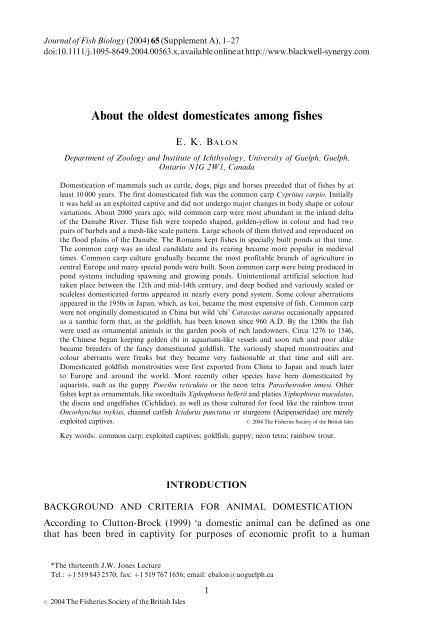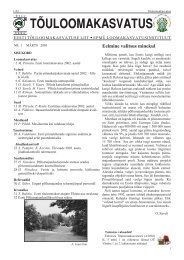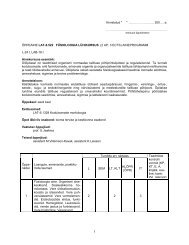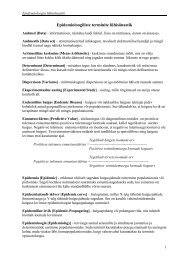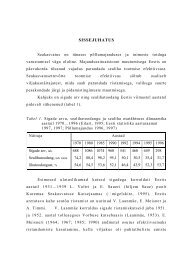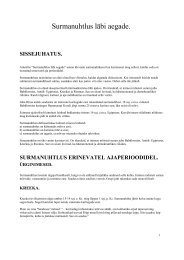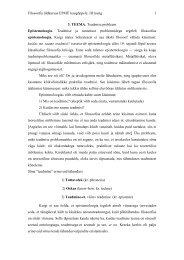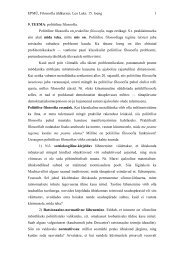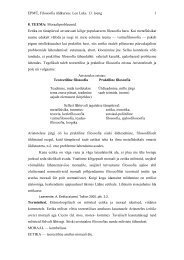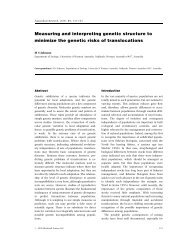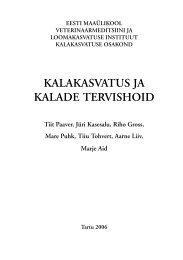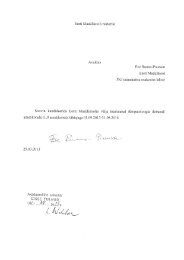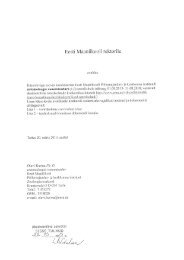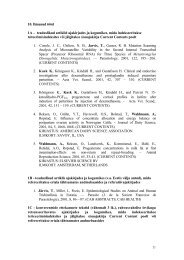About the oldest domesticates among fishes
About the oldest domesticates among fishes
About the oldest domesticates among fishes
Create successful ePaper yourself
Turn your PDF publications into a flip-book with our unique Google optimized e-Paper software.
Journal of Fish Biology (2004) 65 (Supplement A), 1–27<br />
doi:10.1111/j.1095-8649.2004.00563.x,availableonlineathttp://www.blackwell-synergy.com<br />
<strong>About</strong> <strong>the</strong> <strong>oldest</strong> <strong>domesticates</strong> <strong>among</strong> <strong>fishes</strong><br />
E. K. BALON<br />
Department of Zoology and Institute of Ichthyology, University of Guelph, Guelph,<br />
Ontario N1G 2W1, Canada<br />
Domestication of mammals such as cattle, dogs, pigs and horses preceded that of <strong>fishes</strong> by at<br />
least 10 000 years. The first domesticated fish was <strong>the</strong> common carp Cyprinus carpio. Initially<br />
it was held as an exploited captive and did not undergo major changes in body shape or colour<br />
variations. <strong>About</strong> 2000 years ago, wild common carp were most abundant in <strong>the</strong> inland delta<br />
of <strong>the</strong> Danube River. These fish were torpedo shaped, golden-yellow in colour and had two<br />
pairs of barbels and a mesh-like scale pattern. Large schools of <strong>the</strong>m thrived and reproduced on<br />
<strong>the</strong> flood plains of <strong>the</strong> Danube. The Romans kept <strong>fishes</strong> in specially built ponds at that time.<br />
The common carp was an ideal candidate and its rearing became more popular in medieval<br />
times. Common carp culture gradually became <strong>the</strong> most profitable branch of agriculture in<br />
central Europe and many special ponds were built. Soon common carp were being produced in<br />
pond systems including spawning and growing ponds. Unintentional artificial selection had<br />
taken place between <strong>the</strong> 12th and mid-14th century, and deep bodied and variously scaled or<br />
scaleless domesticated forms appeared in nearly every pond system. Some colour aberrations<br />
appeared in <strong>the</strong> 1950s in Japan, which, as koi, became <strong>the</strong> most expensive of fish. Common carp<br />
were not originally domesticated in China but wild ‘chi’ Carassius auratus occasionally appeared<br />
as a xanthic form that, as <strong>the</strong> goldfish, has been known since 960 A.D. By <strong>the</strong> 1200s <strong>the</strong> fish<br />
were used as ornamental animals in <strong>the</strong> garden pools of rich landowners. Circa 1276 to 1546,<br />
<strong>the</strong> Chinese began keeping golden chi in aquarium-like vessels and soon rich and poor alike<br />
became breeders of <strong>the</strong> fancy domesticated goldfish. The variously shaped monstrosities and<br />
colour aberrants were freaks but <strong>the</strong>y became very fashionable at that time and still are.<br />
Domesticated goldfish monstrosities were first exported from China to Japan and much later<br />
to Europe and around <strong>the</strong> world. More recently o<strong>the</strong>r species have been domesticated by<br />
aquarists, such as <strong>the</strong> guppy Poecilia reticulata or <strong>the</strong> neon tetra Paracheirodon innesi. O<strong>the</strong>r<br />
<strong>fishes</strong> kept as ornamentals, like swordtails Xiphophorus hellerii and platies Xiphophorus maculatus,<br />
<strong>the</strong> discus and angel<strong>fishes</strong> (Cichlidae), as well as those cultured for food like <strong>the</strong> rainbow trout<br />
Oncorhynchus mykiss, channel catfish Ictalurus punctatus or sturgeons (Acipenseridae) are merely<br />
exploited captives. # 2004 The Fisheries Society of <strong>the</strong> British Isles<br />
Key words: common carp; exploited captives; goldfish; guppy; neon tetra; rainbow trout.<br />
INTRODUCTION<br />
BACKGROUND AND CRITERIA FOR ANIMAL DOMESTICATION<br />
According to Clutton-Brock (1999) ‘a domestic animal can be defined as one<br />
that has been bred in captivity for purposes of economic profit to a human<br />
*The thirteenth J.W. Jones Lecture<br />
Tel.: þ1 519 843 2570; fax: þ1 519 767 1656; email: ebalon@uoguelph.ca<br />
# 2004 The Fisheries Society of <strong>the</strong> British Isles<br />
1
2 E. K. BALON<br />
community that maintains total control over its breeding, organization of<br />
territory, and food supply’. This definition of domestication applies also to<br />
<strong>fishes</strong> subject to some amendments (Diamond, 2002). Definitive answers to<br />
<strong>the</strong> questions of where and how organisms were first domesticated are rare<br />
(Zeuner, 1963; Isaac, 1970) because most of <strong>the</strong>se domestications happened as<br />
early as <strong>the</strong> Neolithic (c. 14 000 years ago). In a truly domesticated organism,<br />
(a) <strong>the</strong> individual is valued and kept for a specific purpose, (b) its breeding<br />
is subject to human control, (c) its behaviour is different from that of <strong>the</strong> wild<br />
ancestor, (d) its morphology and physiology exhibit variations never seen in<br />
<strong>the</strong> wild and (e) some individuals at least would not survive without human<br />
protection.<br />
The best known examples of domestication are <strong>the</strong> transformations of wolves<br />
into breeds of dog, aurochs into cattle, guanaco into llama and alpaca, wild<br />
boar into domestic swine, Przewalski’s wild horse into domestic horses, and red<br />
jungle fowl into domestic chickens. Dependence is <strong>the</strong> most important <strong>among</strong><br />
<strong>the</strong> more obvious criteria as ‘all domesticated animals depend for <strong>the</strong>ir day-today<br />
survival upon <strong>the</strong>ir owners’ (Livingston, 1994).<br />
Dependence also applies to animals in <strong>the</strong> first step of domestication, which<br />
Clutton-Brock (1999) calls exploited captives. Many attempts at domestication<br />
remain only at that level including most <strong>fishes</strong> cultured for food or ornament,<br />
especially where wild individuals are occasionally brought into <strong>the</strong> stock for<br />
breeding in captivity. For a fish to be a true domesticate criteria (d) and (e)<br />
above must apply. Some of <strong>the</strong>se variants in colour and form would not survive<br />
without human protection. The original criterion of economic profit may only<br />
partially apply to <strong>domesticates</strong> when kept as pets.<br />
DOMESTICATION OF FISHES<br />
Fishes were domesticated much later than many o<strong>the</strong>r animals and plants,<br />
now fixed by Diamond (2002) at c. 10 500 years ago. Only <strong>the</strong> wild common<br />
carp Cyprinus carpio L., acquired c. 2000 years ago by <strong>the</strong> Romans in southcentral<br />
Europe (Balon, 1974, 1995a, b), and <strong>the</strong> goldfish Carassius auratus (L.)<br />
selected and released into ‘ponds of mercy’ c. 1000 years ago in China (Chen,<br />
1956) qualify as ‘true <strong>domesticates</strong>’.<br />
Common carp and goldfish both started to be changed into true domesticated<br />
animals in early medieval times, although in different parts of <strong>the</strong> world and for<br />
different purposes (Chen, 1956; Balon, 1969, 1974; Hoffmann, 1995a). In<br />
contrast to <strong>the</strong> extinct aurochs, ancestors of domestic cattle or <strong>the</strong> nearly extinct<br />
Przewalski horse, only <strong>the</strong> wild common carp may be close to extinction to be<br />
replaced in <strong>the</strong> wild by feral progeny of domesticated forms.<br />
The loss of <strong>the</strong> ancestral wild forms of any domesticated organism is a<br />
loss of epigenetic potential (Balon, 2002). Clutton-Brock (1999) believes ‘that<br />
animals bred under domestication evolve into new species as a result of reproductive<br />
isolation from <strong>the</strong>ir wild progenitors’. Domesticated animals released into<br />
<strong>the</strong> wild to fend for <strong>the</strong>mselves usually perform poorly and, while some revert to<br />
resemble <strong>the</strong>ir wild ancestors in time, <strong>the</strong> process is nearly always incomplete.<br />
All such feral forms remain poor facsimiles of <strong>the</strong>ir progenitors (Livingston,<br />
1994).<br />
# 2004 The Fisheries Society of <strong>the</strong> British Isles, Journal of Fish Biology 2004, 65 (Supplement A), 1–27
OLDEST FISH DOMESTICATES 3<br />
Exploited captives are little changed from <strong>the</strong>ir wild ancestral form and can<br />
usually be returned to <strong>the</strong> wild. Animals become domesticated when <strong>the</strong>y<br />
change form, function, colour and behaviour and often only partially resemble<br />
<strong>the</strong>ir wild ancestors, and survive poorly as feral forms if returned to <strong>the</strong> wild<br />
without human protection.<br />
A few species have been domesticated by <strong>the</strong> aquarium industry, including<br />
guppy Poecilia reticulata Peters, swordtails Xiphophorus hellerii Heckel, platies<br />
Xiphophorus maculatus (Gu¨n<strong>the</strong>r), mollies Poecilia sp., neon tetra Paracheirodon<br />
innesi (Myers), discus and angel<strong>fishes</strong> (Cichlidae) for ornamental and zebrafish<br />
Danio rerio (Hamilton) for research, although some of <strong>the</strong>se are of questionable<br />
status. Fishes reared in captivity for human food, including rainbow<br />
trout Oncorhynchus mykiss (Walbaum), channel catfish Ictalurus punctatus<br />
(Rafinesque), salmonids, Chinese and Indian pelagic spawning carps<br />
(Cyprinidae), tilapias (Cichlidae) and sturgeons (Acipenseridae), are exploited<br />
captives. Some of <strong>the</strong>se do have variants, such as albino strains, that would<br />
qualify <strong>the</strong>m as domesticated.<br />
THE COMMON CARP<br />
Common carp always have two external barbels on each side of <strong>the</strong> upper<br />
jaw; goldfish have none. The body cavity of goldfish is lined with a dark brown<br />
or black pigmented peritoneum, whereas <strong>the</strong> peritoneum of <strong>the</strong> common carp is<br />
unpigmented. The Chinese name for carp includes several cultured genera and<br />
species, which is still confusing authors working on <strong>the</strong> origin of common carp<br />
domestication. The frequent claims that domesticated common carp came to<br />
Europe from China is based on past misidentification of <strong>the</strong> two species and on<br />
<strong>the</strong> continued repetition of this misconception (Leonhardt, 1906; Rudzin´ski,<br />
1961; Tamura, 1961; Hickling, 1962; Steffens, 1967, 1980; Borgese, 1980; Liu,<br />
2003).<br />
Details on <strong>the</strong> origins of <strong>the</strong> common carp have already been given by Balon<br />
(1974): ‘The latest, Chinese study . . . . . . on pond culture stated that ‘‘thanks to<br />
<strong>the</strong> creative efforts of <strong>the</strong> Chinese people for many generations, breeding of <strong>the</strong><br />
carp in this country has proceeded successfully for >2000 years. From China<br />
<strong>the</strong> breeding of this fish spread all over <strong>the</strong> world. From Asia <strong>the</strong> rearing of <strong>the</strong><br />
carp spread to Europe and later to America, Australia, and Africa’’.’ Now it is<br />
time to put this myth to rest.<br />
Kwai Sin Chak Shik, a book written during <strong>the</strong> Sung Dynasty in A.D. 1243,<br />
describes how ‘carp’ fry were transported in bamboo baskets in much <strong>the</strong> same<br />
way as <strong>the</strong>y are transported and traded today. Fry were collected in rivers and<br />
reared in ponds as recorded in A Complete Book of Agriculture, written in A.D.<br />
1639. But if <strong>the</strong> fish fry were collected in rivers, it is doubtful whe<strong>the</strong>r <strong>the</strong>y were<br />
C. carpio, which is not a riverine pelagic spawner. They were more likely <strong>the</strong><br />
young of grass carp Ctenopharyngodon idella (Valenciennes), silver carp<br />
Hypophthalmichthys molitrix (Valenciennes), bighead carp Aristichthys nobilis<br />
(Richardson) and black carp Mylopharyngodon piceus (Richardson), which are<br />
true riverine pelagic spawners and cannot be bred in ponds or rice paddies.<br />
Fur<strong>the</strong>rmore, no domesticated forms of common carp, like <strong>the</strong> mirror or<br />
lea<strong>the</strong>r, or even <strong>the</strong> high-bodied forms (Pokorny´ et al., 1995), were ever reported<br />
# 2004 The Fisheries Society of <strong>the</strong> British Isles, Journal of Fish Biology 2004, 65 (Supplement A), 1–27
4 E. K. BALON<br />
from China prior to known introductions from Europe (Wohlfarth, 1986).<br />
Fur<strong>the</strong>rmore, Chinese carp resemble feral carp, in most of <strong>the</strong> traits in which<br />
<strong>the</strong> races differ than do <strong>the</strong> European fish (Wohlfarth, 1984). Chinese common<br />
carp should be regarded as a semi-domesticated animal, since wild fish are<br />
frequently added to breeding stocks. Therefore, <strong>the</strong> view that common carp<br />
were domesticated in China >2000 years ago is a myth. In China <strong>the</strong> common<br />
carp remains an exploited captive or a feral form of <strong>the</strong> introduced European<br />
domesticated strains.<br />
Even if <strong>the</strong> common carp had been domesticated independently in China<br />
much earlier than in Europe, <strong>the</strong> European domestic forms were later<br />
introduced to eastern Asia (Basavaraju et al., 2003). It is unlikely that any<br />
domesticated carp remain in China or Japan that are pure-bred descendants<br />
of fish originally domesticated in <strong>the</strong>se countries. Common carp were known<br />
and used in <strong>the</strong> fish culture of western Europe well before any direct European<br />
contact with China (Hoffmann, 1995a). The fish culture methods used in <strong>the</strong><br />
west since 1200, was based on dedicated ponds kept permanently filled for<br />
several years during <strong>the</strong> growth of a single age class and <strong>the</strong>n dried for a time<br />
after harvest. This is <strong>the</strong> reverse of <strong>the</strong> fish culture integrated with paddy rice<br />
cultivation practiced in <strong>the</strong> east.<br />
Taxonomy<br />
Cyprinus carpio is taxonomically a most confusing species. According to <strong>the</strong><br />
latest review by Barusˇ et al. (2002) it remains without a holotype and was<br />
described ‘using specimens from pond culture, designating Europe as <strong>the</strong> terra<br />
typica. Presuming that all domestic European forms originated as wild carps from<br />
<strong>the</strong> Danube, specimens from <strong>the</strong> Danube River can be considered as typical’.<br />
Most of <strong>the</strong> confusion comes from giving quasi taxonomic names to feral<br />
specimens or populations. For example, Wu (1977) lists many, Zhou & Chu<br />
(1986) list 12 species from Yunan Province, China, and Barusˇ et al. (2002) cite<br />
>30 synonyms and over 10 sub-species, varieties and morphs from across its<br />
range. This compares with those given by Kottelat (1997) of c. 15 sub-species<br />
and eight varieties and morphs. Using <strong>the</strong> best data available, Barusˇ et al.<br />
(2002,) concluded that only three sub-species of C. carpio can be recognized:<br />
(1) <strong>the</strong> European and central Asian common wild carp, Cyprinus carpio carpio<br />
L., (2) <strong>the</strong> east Asian common wild carp, Cyprinus carpio haematopterus<br />
(Temminck & Schlegel) and (3) <strong>the</strong> south-east Asian wild carp, C. carpio<br />
viridiviolaceus Lacepède. None of <strong>the</strong> data are convincing, nor is <strong>the</strong> claimed<br />
occurrence of C. c. haematopterus throughout east Asia from <strong>the</strong> Amur River<br />
across China, Korea and Japan. Cyprinus haematopterus was described as a<br />
separate species from <strong>the</strong> area of Nagasaki, Japan by Temminck & Schlegel in<br />
1845.<br />
More than 200 years earlier, <strong>the</strong> first colonies of Portuguese and Dutch were<br />
established at Nagasaki. Common carp culture was by <strong>the</strong>n widespread in <strong>the</strong><br />
European homelands of <strong>the</strong>se colonists and it is, <strong>the</strong>refore, possible that <strong>the</strong><br />
common carp was introduced by <strong>the</strong>m to Japan (Balon, 1995b). Tableware<br />
decorated with common carp images once belonging to <strong>the</strong>se early Dutch<br />
colonists can be seen on display in a Nagasaki Museum (Balon, 1995b). While<br />
C. c. haematopterus became <strong>the</strong> nominal sub-species for China, it is possible that<br />
# 2004 The Fisheries Society of <strong>the</strong> British Isles, Journal of Fish Biology 2004, 65 (Supplement A), 1–27
<strong>the</strong>se were feral descendants of domesticated European fish that escaped or<br />
were introduced in Japan and possibly China. This taxonomic confusion may be<br />
resolved by molecular markers but it would be more prudent to consider <strong>the</strong><br />
wild ancestor of <strong>the</strong> common carp as a single species, Cyprinus carpio, widely<br />
distributed from <strong>the</strong> Danube to <strong>the</strong> Amur rivers, as feral forms elsewhere and as<br />
naturalized wherever suitable conditions prevail (Lever, 1996).<br />
Wild common carp, <strong>the</strong> ancestor of <strong>the</strong> domesticated forms<br />
All data so far point to wild common carp from <strong>the</strong> Danube River as <strong>the</strong><br />
most ancestral form that was initially kept as exploited captives and later<br />
domesticated (Fig. 1). The inland delta of this river has been badly degraded<br />
by <strong>the</strong> Gabčikovo Dam (Balon & Holcˇı´k, 1998, 1999), and common carp<br />
remains, found in excavations of Roman settlements in this area confirm that<br />
<strong>the</strong> fish was already of interest at that time (Balon, 1995b). Therefore, <strong>the</strong><br />
present paper will focus entirely on describing <strong>the</strong> wild common carp from<br />
this area before it was extirpated or replaced by feral forms.<br />
Around 1955 large schools of <strong>the</strong> wild common carp were still spawning every<br />
year on inundated meadows along <strong>the</strong> Slovak part of <strong>the</strong> Danube and Lesser<br />
Danube (Misˇı´k, 1957; Be´l, 1962). Detailed studies of <strong>the</strong>se fish were undertaken<br />
(a)<br />
(b)<br />
OLDEST FISH DOMESTICATES 5<br />
FIG. 1. A wild common carp (a) and its feral form (b) from <strong>the</strong> Danube delta in 1900 (from Antipa,<br />
1909).<br />
# 2004 The Fisheries Society of <strong>the</strong> British Isles, Journal of Fish Biology 2004, 65 (Supplement A), 1–27
6 E. K. BALON<br />
on <strong>the</strong> assumption that <strong>the</strong>se fish are <strong>the</strong> direct descendants of <strong>the</strong> much larger<br />
schools of wild common carp that <strong>the</strong> Celts and Romans exploited in <strong>the</strong> same<br />
area c. 2000 years earlier (Balon & Misˇı´k, 1956; Balon, 1957, 1958a, b; Misˇı´k,<br />
1958). These studies were already reviewed (Fig. 2) and <strong>the</strong> life history and<br />
ecology of <strong>the</strong> wild common carp compiled in detail by Balon (1974, 1995a,<br />
b) and Barusˇ et al. (2002).<br />
Lucullan demands, Pannonia and <strong>the</strong> first carp captives<br />
Two significant historical events coincided and contributed to <strong>the</strong> development<br />
of wild common carp from <strong>the</strong> inland delta of <strong>the</strong> Danube as a major food<br />
source and as an exploited captive.<br />
In <strong>the</strong> last years B.C. and in <strong>the</strong> first and second century A.D., <strong>the</strong> Romans<br />
developed a luxurious lifestyle with an equally elaborate cuisine that led to <strong>the</strong><br />
(a)<br />
(b)<br />
(c)<br />
1<br />
5 cm<br />
4<br />
3<br />
20<br />
5<br />
P<br />
12<br />
26<br />
1513<br />
28<br />
27<br />
V<br />
D<br />
14<br />
21 18<br />
FIG. 2. (a) Wild Cyprinus carpio carpio from <strong>the</strong> Danube River arm near Medved’ov, captured 21 May<br />
1954, (b) scheme for counting <strong>the</strong> meristic characters and (c) scheme for mensural characters<br />
(rearranged from Misˇı´k, 1958).<br />
# 2004 The Fisheries Society of <strong>the</strong> British Isles, Journal of Fish Biology 2004, 65 (Supplement A), 1–27<br />
16<br />
17<br />
19<br />
29<br />
A<br />
22<br />
24<br />
2<br />
C<br />
23<br />
25
importation of foreign foods (Friedla¨nder, 1936). Sergius Orata, Cicero’s<br />
teacher, devised special reservoirs where <strong>fishes</strong> for <strong>the</strong> kitchen were stored.<br />
These reservoirs called piscinae soon became very fashionable, for <strong>the</strong>y ensured<br />
a permanent supply of a variety of fresh <strong>fishes</strong> independent of wea<strong>the</strong>r conditions<br />
and fishing success (Zeuner, 1963). Individuals such as Lucinius<br />
Muraena adopted fish rearing in piscinae, and added freshwater <strong>fishes</strong> to <strong>the</strong><br />
initially stored marine ones (Pliny <strong>the</strong> Elder in translation 1958–1962). The<br />
patricians soon competed in building such piscinae; consul Lucullus (75 B.C.),<br />
whose reputation as a gourmet was well-known, dug a trench through a hill<br />
near Naples to bring water to his ponds that cost more than his villa. Varro<br />
(116–27 B.C.; 1912) and Columella (–50 A.D.; 1941–1968) claimed that <strong>the</strong><br />
Roman patricians preferred seawater ponds, and that freshwater ponds (piscinae<br />
dulces) were considered plebeian, but <strong>the</strong> documented prejudice is proof of <strong>the</strong>ir<br />
existence. Also, <strong>the</strong> existence of plebeian owned freshwater fish ponds may<br />
signify that <strong>the</strong> desire to transport a wild common carp from <strong>the</strong> Danube to<br />
patrician piscinae in Italy was applicable also to plebeian troops and <strong>the</strong><br />
accompanying tradesmen and artisans (Hoffmann, 1995a).<br />
In <strong>the</strong> first years AD, <strong>the</strong> Roman Empire expanded its nor<strong>the</strong>rn boundary<br />
beyond <strong>the</strong> barrier of <strong>the</strong> Alps right up to <strong>the</strong> shores of <strong>the</strong> Danube River<br />
(Sitwell, 1981). The nor<strong>the</strong>rnmost province, Pannonia, faced formidable forces<br />
of Celts and Germans across <strong>the</strong> Danube and <strong>the</strong> Empire had to establish a<br />
strong military presence (Fig. 3). In <strong>the</strong> second century, <strong>the</strong> comparatively short<br />
stretch of river between Vienna and Budapest, c. 150 miles long, required no less<br />
than four legions to guard it. At least 20 000 fighting legionnaires were accompanied<br />
by supporting troops, wives, mistresses, children, slaves and tradesmen<br />
to a total of >100 000 Romans. These, toge<strong>the</strong>r with <strong>the</strong> indigenous communities<br />
formed a human population large enough to establish a carp-eating tradition, if<br />
wild carp was, at least seasonally, <strong>the</strong> most abundant and easily caught fish in<br />
<strong>the</strong> area.<br />
Archeological excavations in <strong>the</strong> region showed abundant fish remains that<br />
revealed that <strong>the</strong> bones of <strong>the</strong> wild common carp dominated all o<strong>the</strong>r fish bones<br />
(K. Hensel, pers. comm.). This constitutes <strong>the</strong> first direct evidence that Romans<br />
Alcmona<br />
Augusta<br />
Vindelicum<br />
Isara<br />
Abodiacum Pons Aoni<br />
Veldidena<br />
Naba<br />
Castra Regina<br />
Castra Batava<br />
Aenus<br />
Danuvius Lauriacum<br />
OLDEST FISH DOMESTICATES 7<br />
Vindobona<br />
Eburodunum<br />
Arlape Cetium Carnumtum<br />
Aquae<br />
Scarbantia<br />
Virunum<br />
Savaria<br />
Marus<br />
Arrabona<br />
Peiso Piso<br />
Danuvius minor<br />
Danuvius<br />
Mogentiana<br />
Amber Road<br />
Duria<br />
Laugaricio<br />
lza<br />
Granua<br />
Brigetio<br />
Aquincum<br />
Vetus Salina<br />
Lussonium<br />
Vistula<br />
Pathisus<br />
River (flumen, fluvius)<br />
Boundary of Empire<br />
Cities and towns<br />
Legionary fortress (castra)<br />
Fort (castella)<br />
Wall (vallum)<br />
Road (via)<br />
Amber (Road)<br />
0 200 km<br />
FIG. 3. The Roman Danube frontier of Pannonia with <strong>the</strong> Amber Road crossing <strong>the</strong> river near<br />
Carnuntum, and <strong>the</strong> major floodplain from Peiso Piso (modern Bratislava) to Celamantia (Izˇa).<br />
# 2004 The Fisheries Society of <strong>the</strong> British Isles, Journal of Fish Biology 2004, 65 (Supplement A), 1–27
8 E. K. BALON<br />
knew <strong>the</strong> wild common carp of <strong>the</strong> Danube. It is most likely, <strong>the</strong>refore, that <strong>the</strong><br />
Romans, while living on <strong>the</strong> Danube in Pannonia not only consumed common<br />
carp but also transported <strong>the</strong>m alive to o<strong>the</strong>r Roman provinces, because of <strong>the</strong><br />
high fashion of that time to keep <strong>fishes</strong> in piscinae. The many thousand soldiers<br />
after returning to Italy probably demanded <strong>the</strong>ir customary fish to be served<br />
and so influenced <strong>the</strong> importation of common carp. After all, <strong>the</strong> common carp<br />
was <strong>the</strong> largest, tastiest fish that would have survived <strong>the</strong> rigours of transport.<br />
There is nearly no written or archeological evidence of common carp being<br />
kept in piscinae or vivaria in Rome 2000 years ago (Zeuner, 1963; Hoffmann,<br />
1995a). Written records from this time are generally scarce and information is<br />
lacking even on activities that are known to have existed at that time. Walton<br />
(1676) quoting Jovius, who was probably Paolo Govio, a papal physician, who<br />
wrote about <strong>fishes</strong> on <strong>the</strong> Roman market in 1524 and recorded that ‘carps of<br />
more than fifty pounds weight’ were to be found in Lake Lurian in Italy.<br />
Probably <strong>the</strong>se early introductions of wild common carp west of <strong>the</strong> middle<br />
Danube were using it only as an exploited captive fish.<br />
The history of common carp domestication<br />
The early assumption that common carp keeping was continued in monastery<br />
ponds after <strong>the</strong> collapse of <strong>the</strong> Roman Empire and <strong>the</strong> establishment of Christianity<br />
is pure conjecture for <strong>the</strong> early middle ages up to <strong>the</strong> 10th century<br />
(Hoffmann, 1995a). This is based on two logical assumptions; firstly, that<br />
monasteries began to be founded in <strong>the</strong> 5th and 6th centuries and soon gained<br />
land and farms; secondly, that Christianity introduced >180 fasting days per<br />
year that monks, nuns and priests had to respect.<br />
During fasting days <strong>the</strong> only animal protein that could be eaten was from<br />
aquatic animals such as shellfish and <strong>fishes</strong>, although unborn rabbits called<br />
laurices were also acceptable in some areas. This links <strong>the</strong>se customs directly to<br />
Roman tradition (Balon, 1995b). The only evidence that <strong>the</strong> Roman taste for<br />
eating common carp continued, however, is from Cassiodorus (490–585 A.D.;<br />
1626) who ordered wild common carp to be delivered from <strong>the</strong> Danube to Italy<br />
for <strong>the</strong> table of King Theoderic.<br />
Albertus Magnus was <strong>the</strong> first to write about breeding common carp in ponds<br />
in <strong>the</strong> 1260s (Magnus 1193–1280; 1861), however, he may compete for this<br />
privilege with <strong>the</strong> Count of Champagne who was breeding common carp in<br />
1258 according to Hoffmann (1994). Ponds with muddy bottoms have been<br />
built since <strong>the</strong> 10th century (Hoffmann, 1985; Andreska, 1987), and wild<br />
common carp became established in <strong>the</strong>m in <strong>the</strong> twelfth century at <strong>the</strong> latest,<br />
judging from <strong>the</strong> relatively fast process of domestication as reported by Tuča<br />
(1958), Bastl (1961) and Misˇı´k & Tuča (1965). So it seems that transition of<br />
common carp from exploited captives to truly domesticated animals took place<br />
in <strong>the</strong> 12th century.<br />
In modern common carp culture, to build a fishpond, not just a holding tank,<br />
is to create a new aquatic habitat. Active construction of ponds for this purpose<br />
got under way in <strong>the</strong> 11th century and increased rapidly in <strong>the</strong> 12th and 13th<br />
century (Hoffmann, 1995a). Initially <strong>the</strong>se ponds were stocked with several local<br />
species but common carp soon proved to be <strong>the</strong> best choice for such man-made<br />
habitats. Hoffmann (1994, 1995a) concluded that ‘<strong>the</strong>re were three phases in <strong>the</strong><br />
# 2004 The Fisheries Society of <strong>the</strong> British Isles, Journal of Fish Biology 2004, 65 (Supplement A), 1–27
OLDEST FISH DOMESTICATES 9<br />
medieval diffusion of common carp to <strong>the</strong> west and north from an epicentre at<br />
<strong>the</strong> north-west margin of its native range in Pannonia (<strong>the</strong> piedmont section of<br />
<strong>the</strong> Danube, Balon, 1967). The first phase, between <strong>the</strong> 7th and 11th centuries,<br />
principally carried <strong>the</strong> fish up <strong>the</strong> Danube and into some west-flowing tributaries<br />
of <strong>the</strong> middle Rhine. Some remains also indicate common carp in waters<br />
north of <strong>the</strong> Danube. In a second phase (12th to <strong>the</strong> early 14th century)<br />
common carp radiated across most of <strong>the</strong> economic and cultural heartland of<br />
medieval north-western Europe, from <strong>the</strong> lower Rhine-Maas region south to <strong>the</strong><br />
Paris basin and Burgundy. A final stage, probably occurring after <strong>the</strong> economic<br />
shift of <strong>the</strong> mid-14th century, extended common carp into <strong>the</strong> outer periphery<br />
of <strong>the</strong> west, an arc from south-western France through England and sou<strong>the</strong>rn<br />
Scandinavia into east central Europe. Though common carp are recorded in<br />
Italy at <strong>the</strong> end of <strong>the</strong> Middle Ages, <strong>the</strong> diffusion pattern at no time accords<br />
with radiation from <strong>the</strong>re’.<br />
In time more written evidence appeared and by <strong>the</strong> early 14th century<br />
common carp culture was established (Pucher, 1987; Hoffmann, 1995b, 2002).<br />
Soon pond common carp management was described in its entirety in <strong>the</strong><br />
famous Latin manual by Jan Dubravius (1547) that was written in 1535 to<br />
1540, and by Olbrycht Strumien´ski (1573) who reported on <strong>the</strong> Czech and<br />
Polish techniques of that time (Strojnowski, 1609; Sˇusta, 1889; Inglot &<br />
Nyrek, 1960; Szczygielski, 1967a, b; Berka, 1986).<br />
The ‘golden age’ of pond construction for rearing of common carp<br />
reappeared after <strong>the</strong> wars and skirmishes of <strong>the</strong> 15th century ended. It has<br />
been estimated that >25 000 common carp ponds were built in Bohemia and<br />
Moravia alone towards <strong>the</strong> end of <strong>the</strong> 15th and <strong>the</strong> beginning of <strong>the</strong> 16th<br />
century. A special guild of mobile and rogue pond builders flourished. During<br />
<strong>the</strong>se 50 years, c. 500 ponds per year, or two ponds per day, were constructed<br />
(Andreska, 1987). Production of <strong>the</strong> common carp for food became <strong>the</strong> most<br />
profitable branch of agriculture (Andreska, 1997; Guziur et al., 2003). Various<br />
wars and a decline in <strong>the</strong> price of common carp later led to a dramatic reduction<br />
in <strong>the</strong> number and area of <strong>the</strong>se ponds, which declined from a total of<br />
180 000 ha to c. 51 000 ha. Rozˇemberg pond, which was built in <strong>the</strong> 16th century<br />
and covers 711 ha is one of <strong>the</strong> 34 largest. It still operates on <strong>the</strong> 2 to 3 year<br />
cycle of common carp production (Kourzil & Guziur, 2004).<br />
Dubravius (1547) recommended a system of several specialized ponds for <strong>the</strong><br />
production of marketable common carp. Smallest of all was <strong>the</strong> spawning pond<br />
with a grassy bottom simulating shallow, freshly flooded meadows. Selected<br />
parent fish were released in groups into it. Soon after spawning, <strong>the</strong> early<br />
juveniles (Balon, 1999) were flushed into nursery ponds, and 1 year later were<br />
transferred into growing ponds. Ponds were left dry in rotation, treated with<br />
lime and various chemical and natural fertilizers in order to enhance <strong>the</strong> natural<br />
food production. Some consider that T. Dubisch, an illiterate Slovak fish master<br />
(Morcinek, 1909), invented <strong>the</strong> system of transferring <strong>the</strong> fish from one growing<br />
pond to <strong>the</strong> next while gradually lowering <strong>the</strong>ir density (Billard, 1999; Guziur<br />
et al., 2003). While <strong>the</strong> production of young common carp in spawning ponds<br />
was recommended for every pond system, this was later, at least partly, replaced<br />
by artificial stripping of gametes under hatchery conditions (Woynarovich,<br />
1962; Billard et al., 1995). The growth of <strong>the</strong> common carp was enhanced by<br />
# 2004 The Fisheries Society of <strong>the</strong> British Isles, Journal of Fish Biology 2004, 65 (Supplement A), 1–27
10 E. K. BALON<br />
ever better formulations of supplementary food, <strong>the</strong> system of sequential,<br />
specially fertilized ponds remained. The production increased from an initial<br />
40 to >450 kg ha 1 (Cˇı´tek et al., 1998), with an ever reducing duration for<br />
growing marketable common carp from 5–6 to 2–4 years (Fig. 4).<br />
Sooner or later different forms of domestic common carp appeared in <strong>the</strong><br />
various pond systems. When <strong>the</strong> wild common carp was introduced into a pond<br />
system it naturally started to change its torpedo-shaped body into a deep,<br />
laterally compressed and hunchbacked body. Soon individuals appeared that<br />
did not have regular, geometrical arrangement of scales but showed severe<br />
irregularities, scale reductions or even complete scalelessness. These variations<br />
soon became a foundation for artificial selection. Ultimately, domesticated<br />
common carp are represented by a variety of forms, such as scaled carp, line<br />
carp, mirror carp, and lea<strong>the</strong>r or naked carps (Brylin´ska, 1986; Gorda et al.,<br />
1995; Pokorny´ et al., 1995).<br />
The domesticated common carp not only changed its external shape, scalation<br />
and colour, but also underwent internal and physiological changes. Detailed<br />
reviews were published elsewhere by Balon (1974, 1995a, b) and Barusˇ et al.<br />
(2002). Briefly, <strong>the</strong> mouth gape, <strong>the</strong> first character that Rudzin´ski (1961) and<br />
Steffens (1964) used for clear distinction between wild and domesticated common<br />
carp, was much smaller in <strong>the</strong> wild than in <strong>the</strong> domesticated varieties<br />
(Table I). Even more pronounced differences are encountered <strong>among</strong> <strong>the</strong><br />
mouth-gape indices calculated by dividing 10 times <strong>the</strong> mouth gape in cm 2 by<br />
length of head in cm: 4 46 to 5 57 for <strong>the</strong> wild common carp and 8 12 for<br />
domesticated fish (Steffens, 1964). Both Rudzin´ski (1961) and Steffens (1964)<br />
FIG. 4. (a), (b) Common carp harvest in sou<strong>the</strong>rn Bohemia near Hluboka and Vodnˇany. (c), (d) harvested<br />
domesticated common carp (early November 1998).<br />
# 2004 The Fisheries Society of <strong>the</strong> British Isles, Journal of Fish Biology 2004, 65 (Supplement A), 1–27
TABLE I. Mouth gape and intestine length indices for <strong>the</strong> wild common carp and<br />
domesticated common carp: o l 1 ,10 mouth gape in cm 2 per standard length (L S)in<br />
cm; o m 1 ,10 mouth gape in cm 2 per mass in g; o lc 1 ,10 mouth gape in cm 2 per<br />
length of head in cm; gut l 1 , length of intestine in cm per 1 cm of L S; gut m 1 , length of<br />
intestine in cm per 10 g of wet mass<br />
Index o l 1<br />
OLDEST FISH DOMESTICATES 11<br />
om 1<br />
olc 1<br />
gut l 1<br />
gut m 1<br />
Wild common carp 1 14<br />
With supplementary diet 1 09 0 10 4 46 2 11 3 02<br />
With natural diet 1 24 0 08 5 27<br />
Domesticated carp 1 91<br />
With supplementary diet 2 00 0 08 8 12 2 64 2 25<br />
With natural diet 2 30 0 08 8 12<br />
considered <strong>the</strong> enlargement of <strong>the</strong> mouth in <strong>domesticates</strong> to be caused by<br />
changes in diet, and possibly <strong>the</strong> result of artificial selection. Domesticated<br />
common carp selected to utilize supplementary food, grew better in ponds<br />
when man-made food was added (Sibbing, 1988). Studies on <strong>the</strong> wild common<br />
carp in ponds (Rudzin´ski, 1961; Leszczyn´ska & Biniakowski, 1967) proved that<br />
wild common carp progeny was better suited for stocking natural riverine<br />
habitats than were domesticated varieties.<br />
Rudzin´ski (1961) found and Steffens (1964) confirmed that <strong>the</strong> intestine of<br />
<strong>the</strong> wild common carp was 15 to 25% shorter than that of a domesticated carp.<br />
The index calculated by dividing <strong>the</strong> length of <strong>the</strong> intestine by standard length<br />
(L S) in cm was 2 11 for <strong>the</strong> wild common carp and 2 64 for <strong>the</strong> domesticated<br />
fish. Longer intestines in domesticated fish are probably due to utilization of<br />
vegetable food not normally consumed by wild common carp. Both authors<br />
also found, when comparing <strong>the</strong> deeper body of domesticated common carp<br />
with <strong>the</strong> cylindrical one of wild common carp, that <strong>the</strong> calculated muscle mass<br />
was <strong>the</strong> same in both, although it appears to be greater in <strong>the</strong> domesticated fish.<br />
This means that <strong>the</strong> dressed mass of <strong>the</strong> domesticated fish is not larger in spite<br />
of <strong>the</strong> different body proportions. Also, wild common carp has both chambers<br />
of <strong>the</strong> swimbladder of similar size, whereas <strong>the</strong> domesticated fish has <strong>the</strong><br />
anterior chamber always much larger and <strong>the</strong> posterior chamber smaller; <strong>the</strong><br />
proportion (%) as given by Steffens (1980) is 61 : 39 for <strong>the</strong> wild and 90 : 10 for<br />
<strong>the</strong> domesticate. This may be related to <strong>the</strong> relative greater mass of <strong>the</strong> head in a<br />
domesticated common carp.<br />
The greater strength of wild common carp is supported by some of its physiological<br />
attributes (Steffens, 1964). Wild common carp has 18 to 19% more erythrocytes<br />
and haemoglobin than domesticated fish and blood sugar level is 16 to 26%<br />
higher in <strong>the</strong> former. Also, wild common carp has a much lower water content in<br />
muscles and liver than domesticated fish. Fur<strong>the</strong>rmore, wild common carp has<br />
greater fat content in individual organs, more glycogen in <strong>the</strong> liver, and more<br />
vitamin A in <strong>the</strong> eyes, intestine and liver. In addition its muscles are better vascularized<br />
and do not fatigue as quickly as do those of domesticated common carp.<br />
As in some exploited captive salmonids (Balon, 1980, 2004) <strong>the</strong>re are some<br />
indications that domesticated common carp usually produce eggs with less yolk<br />
# 2004 The Fisheries Society of <strong>the</strong> British Isles, Journal of Fish Biology 2004, 65 (Supplement A), 1–27
12 E. K. BALON<br />
and as a consequence more altricial progeny than <strong>the</strong> ancestral wild form<br />
(Kryzhanovsky et al., 1951; Balon, 1958a; Penˇáz, 1995).<br />
Specific forms of <strong>the</strong> domesticated common carp are created and maintained<br />
through constant artificial selection in nearly every pond culture system. Standardized<br />
breeds were developed and new forms continue to be constantly tested<br />
in some institutes, such as <strong>the</strong> Fish Culture Research Institute at Szarvas,<br />
Hungary, <strong>the</strong> Institute of Ichthyobiology and Pond Culture of <strong>the</strong> Polish<br />
Academy of Sciences at Gołysz, Poland, and <strong>the</strong> Research Institute of Fishery<br />
and Hydrobiology of <strong>the</strong> Sou<strong>the</strong>rn Bohemian University at Vodnˇany, Czech<br />
Republic (Billard & Gall, 1995; Gorda et al., 1995; Pokorny´ et al., 1995;<br />
Flajsˇhans, 1996; Varadi et al., 2002; Guziur et al., 2003). The common carp is<br />
considered a delicacy in Europe, and is served particularly at Christmas (Balon,<br />
1966). The fish, however, is appreciated throughout <strong>the</strong> year and is served in<br />
special restaurants. A dedicated cookbook containing >84 recipes for domesticated<br />
common carp dishes was written around 1927 (Vanˇha, 1993).<br />
The emergence of koi – <strong>the</strong> most expensive fish in <strong>the</strong> world<br />
Common carp was traditionally reared for human food in small terrace ponds<br />
alternating with rice paddies between Nagaoka and Ojiya cities of Niigata<br />
Prefecture, c. 280 km west of Tokyo, Japan. The area is known to have one of<br />
<strong>the</strong> highest snowfalls in <strong>the</strong> world and <strong>the</strong> whole area is under at least 6 m of<br />
snow for c. 6 months. These unusual conditions may have contributed to <strong>the</strong><br />
more frequent occurrence of colour aberrations in common carp cultured here.<br />
The high incidence of colour aberrations may be caused by melatonin production<br />
during <strong>the</strong> prolonged life in total darkness under <strong>the</strong> cover of deep snow.<br />
In <strong>the</strong> past, this mountainous area had only few roads and <strong>the</strong> local farmers<br />
were often isolated during winter months. It is assumed that, c. 180 years ago,<br />
coloured aberrants of <strong>the</strong> common carp began to be selected and crossbred here<br />
(Kataoka, 1989; Kuroki, 1990). There is, however, little evidence to support<br />
such early appearance of ‘nishikigoi’. Plate 16 in volume one of Illustrations of<br />
Japanese Aquatic Plants and Animals, published in 1931, shows some coloured<br />
carps but no modern ‘nishikigoi’ (Ishikawa et al., 1931; Balon, 1995b). Consequently,<br />
although coloured common carp is recorded from >70 years ago,<br />
commercial scale selection of true ‘nishikigoi’ (koi) probably started only in<br />
<strong>the</strong> 1950s. By <strong>the</strong>n, increased living standards in Japan and elsewhere allowed<br />
more people to afford garden ponds. Especially in Japan, where land is more<br />
precious than in most o<strong>the</strong>r parts of <strong>the</strong> world and Buddhism favours a love of<br />
animals, garden pools were used fully for decoration and ‘swimming flowers’<br />
were a logical progression in <strong>the</strong> development of <strong>the</strong> miniature garden. Even in<br />
<strong>the</strong> early days of koi popularity, Amano (1968) recorded an annual production<br />
of some 10 million fish, amounting to ‘1 000 000 000 yen worth’.<br />
Koi, as <strong>the</strong>y are known today (Axelrod et al., 1996), are colour aberrations<br />
C. carpio. They probably originated from domesticated common carp or its feral<br />
forms, and from some more recent imports from Europe (doitsu koi). When<br />
colour aberrations started to appear more frequently and demands for <strong>the</strong>m<br />
increased, production and crossbreeding intensified and <strong>the</strong>ir progeny were<br />
severely culled, leaving only <strong>the</strong> best coloured individuals one out of 10 000 or<br />
more, for fur<strong>the</strong>r breeding. The first modern ‘nishikigoi’ come from 30 hamlets<br />
# 2004 The Fisheries Society of <strong>the</strong> British Isles, Journal of Fish Biology 2004, 65 (Supplement A), 1–27
OLDEST FISH DOMESTICATES 13<br />
FIG. 5. (a) The koi ponds at Yamakoshi, Japan, (b) selected 3 year-old individuals at <strong>the</strong> breeder’s pond,<br />
(c) in <strong>the</strong> garden of a rich hobbyist in Kyoto and (d) at <strong>the</strong> wholesaler in Ojiya, Niigata Prefecture,<br />
Japan.<br />
of Yamakoshi in <strong>the</strong> Niigata Prefecture (Fig. 5) where 87% of <strong>the</strong> 906 families<br />
became ‘fancy carp’ producers (Amano, 1971).<br />
Today, <strong>the</strong> Japanese recognize c. 15 basic colour aberrants of <strong>the</strong> common<br />
carp that are called koi. Each of <strong>the</strong>se aberrants has many varieties (Phipps,<br />
1989; Kuroki, 1990). The standard is for <strong>the</strong> carp body to remain cylindrical<br />
and <strong>the</strong> colours to be viewed from above. Koi with elongated fins and scale or<br />
body deformation is not accepted in Japan but appears frequently from producers<br />
in Israel and elsewhere. The colours resulting from crossing <strong>the</strong> severely<br />
culled offspring are impossible to predict, even with <strong>the</strong> most careful parent<br />
selection (Kataoka, 1989). After several cullings only <strong>the</strong> most promising and<br />
# 2004 The Fisheries Society of <strong>the</strong> British Isles, Journal of Fish Biology 2004, 65 (Supplement A), 1–27
14 E. K. BALON<br />
appealing colours are retained and from <strong>the</strong>se grow numerous beautiful<br />
‘nishikigoi’ (Balon, 1995b). The winners of shows, however, are but a few<br />
unique individuals selected from many hundreds of thousands. In Japan <strong>the</strong><br />
favourites are ‘koˆhaku’ (red and white koi), ‘taisho-sanke’ (red, black and white)<br />
and ‘showa sanshoku’ (a black koi with white and red imposed). As no two<br />
specimens are ever alike, <strong>the</strong> grand champions of modern shows commonly sell<br />
for considerable amounts of money.<br />
THE GOLDFISH<br />
The goldfish has long been <strong>the</strong> most domesticated fish and now seems to be<br />
better adapted to confinement than to a ‘free life’ (Taylor, 1884). It has been an<br />
animal of choice for laboratory experiments in physiology (Ostrander, 2000)<br />
and is particularly susceptible to <strong>the</strong> effects of alcohol (Hartston, 1987) and so is<br />
a good model for research on <strong>the</strong> effects of alcohol.<br />
Goldfish are often confused with <strong>the</strong> crucian carp Carassius carassius (L.),<br />
Prussian carp Carassius auratus gibelio (Bloch) or even common carp<br />
(Szczerbowski & Szczerbowski, 1996). There is no reason for this confusion as<br />
goldfish have no barbels while common carp do. The crucian carp differs from<br />
<strong>the</strong> goldfish by (a) having 23 to 33 gill rakers on <strong>the</strong> first branchial arch while<br />
goldfish have 37 to 53, (b) having 28 to 29 fine denticles on <strong>the</strong> posterior edge of<br />
<strong>the</strong> last unbranched spiny ray of <strong>the</strong> dorsal fin while goldfish have 10 to 11<br />
irregular denticles, (c) by having a light peritoneum while goldfish has a black<br />
peritoneum and (d) by having a blackish spot at <strong>the</strong> base of <strong>the</strong> caudal fin while<br />
goldfish have none. Body colour of <strong>the</strong> crucian carp is usually coppery gold<br />
while that of <strong>the</strong> wild goldfish is silvery-grey. In spite of <strong>the</strong>se differences, most<br />
FAO statistics erroneously list goldfish as crucian carp, but crucian carp is<br />
rarely used in aquaculture and is quite infrequent. The same mistake can be<br />
found in some aquarium literature (Matsui & Axelrod, 1991), and even in <strong>the</strong><br />
newest encyclopedia (Liu, 2003) although in <strong>the</strong> first edition all was correct<br />
(Grzimek & Ladiges, 1973).<br />
The crucian carp occurs in two morphs: <strong>the</strong> precocial, fast growing and deep<br />
bodied and <strong>the</strong> altricial, dwarfed morpha humilis (Szczerbowski & Szczerbowski,<br />
1996, 2002). The fish occurs in most of Eurasia, except in <strong>the</strong> north-western<br />
and south-western parts of Europe, China, Korea and Japan. Expanding populations<br />
of Prussian carp replaced C. carassius in many locations. Kottelat (1997)<br />
recognized C. gibelio (Bloch) as a separate species. Prussian carp is silvery in<br />
colour, and is a gynogenetic, all female, triploid sub-species (Pelz, 1987;<br />
Halačka & Lusková, 2000) that lives in <strong>the</strong> peripheral areas of <strong>the</strong> distribution<br />
of <strong>the</strong> nominal wild goldfish. The Prussian carp with both sexes present, occurs<br />
only close to <strong>the</strong> distribution of <strong>the</strong> goldfish. The wild goldfish is native to<br />
China, <strong>the</strong> sou<strong>the</strong>rn Amur River basin and Korea. It was introduced to Japan<br />
from China between 1502 and 1620 (Matsui, 1934). Available data show that<br />
<strong>the</strong> systematics of <strong>the</strong> genus Carassius in East Asia is confusing (Hensel, 1971;<br />
Kawanabe & Mizuno, 1989), and Kottelat (1997) recognizes at least five genetically<br />
and morphologically distinct stocks in Japan, which are considered distinct<br />
species or sub-species.<br />
# 2004 The Fisheries Society of <strong>the</strong> British Isles, Journal of Fish Biology 2004, 65 (Supplement A), 1–27
OLDEST FISH DOMESTICATES 15<br />
All three most common Carassius species, <strong>the</strong> crucian carp, goldfish and<br />
Prussian carp, reach an average size of c. 35 cm and a body mass of 1 kg.<br />
Crucian carp and goldfish were distinguished during <strong>the</strong> Sung Dynasty after<br />
968 A.D., claims Szczerbowski (2002), but since <strong>the</strong>se two species do not<br />
naturally occur in sympatry this claim may be without foundation. The<br />
goldfish, was introduced to Europe and elsewhere from China as an already<br />
domesticated monstrosity. ‘Valenciennes (1842: 108) summarized <strong>the</strong> history of<br />
<strong>the</strong> introduction of Carassius auratus to Europe [writes Kottelat, 1997, p. 52].<br />
He states that some authors (but does not say which ones) consider that it was<br />
introduced to Europe as early as 1611 or 1691 and that Yarrell reports that it<br />
had been introduced by <strong>the</strong> Portuguese from Java (. . .) to South Africa and<br />
from <strong>the</strong>re to Lisboa. The first introduction to England dates to 1691 (Pennant,<br />
1812: 490) and to France to 1755 (Hervey & Hems, 1968. . .). It was bred in<br />
nor<strong>the</strong>rn Europe for <strong>the</strong> first time in Holland in 1728 according to Sterba (1987:<br />
272).’ Before this, domesticated goldfish had to come by boat from China and<br />
must have been very expensive. As such <strong>the</strong>ir owners would guard <strong>the</strong>m from<br />
release into natural waters. Invasions from aquaria and garden pools into all<br />
suitable habitats around <strong>the</strong> world came later.<br />
Purnell’s Encyclopedia of Animal Life (Burton, 1969) makes <strong>the</strong> following<br />
statement with regard to goldfish: ‘The more fancy breeds of goldfish are freaks,<br />
no matter how attractive some of <strong>the</strong>m may look. To recite <strong>the</strong>ir names is<br />
enough to make this point: veiltail, eggfish, telescope, calico, celestial, lionhead,<br />
tumbler, comet or meteor and pearl scale. There are also <strong>the</strong> water bubble eye,<br />
blue fish, brown fish, brocade, pompon and fantail and many o<strong>the</strong>rs. Some<br />
breeds are monstrosities ra<strong>the</strong>r than freaks’.<br />
Wild goldfish, <strong>the</strong> ancestor of <strong>the</strong> domesticated monstrosities<br />
The wild goldfish has a deep body, silver-grey or olive-green colouration and<br />
thick caudal peduncle. The body is covered by large cycloid scales, and <strong>the</strong><br />
upper edge of <strong>the</strong> dorsal fin is slightly concave. Its feral forms are mostly<br />
slimmer and smaller, much like <strong>the</strong> altricial morpha humilis common in <strong>the</strong><br />
crucian carp. The low and round body form, however, is also common in <strong>the</strong><br />
wild goldfish and in <strong>the</strong> silver-greyfish caught for food by Chinese fishermen.<br />
The domesticated goldfish ancestor, ‘chi’, has a relatively short snout, 25 to<br />
37% of head length, small, protrusible mouth, and 0 4–4 0 pharyngeal teeth.<br />
The morphometric and meristic characters differ little between <strong>the</strong> wild goldfish<br />
from China and <strong>the</strong> Prussian carp from <strong>the</strong> Amur River (Table II), although <strong>the</strong><br />
data from various operators and times may be imprecise.<br />
Gynogenetic forms are rarely found in <strong>the</strong> goldfish. Originally, <strong>the</strong> number of<br />
chromosomes was reported to be 94 (2n) in <strong>the</strong> goldfish (Makino, 1939), and<br />
bisexual populations of <strong>the</strong> Prussian carp (Cherfas, 1966). In Vasilyev’s (1985)<br />
review, however, goldfish had 100 (2n) chromosomes and in Chiarelli et al.<br />
(1969) 104 (2n) chromosomes. The triploid forms that reproduce by gynogenesis<br />
have 141 to 160 (3n) chromosomes (Penˇa´z et al., 1979). The goldfish is <strong>the</strong> only<br />
cyprinid that has morphologically differentiated sex chromosomes (Szczerbowski,<br />
2002).<br />
The goldfish is a portional spawner and releases two to three batches of eggs at<br />
each mating at 8 to 10 day intervals. It deposits adhesive eggs on grass and fine<br />
# 2004 The Fisheries Society of <strong>the</strong> British Isles, Journal of Fish Biology 2004, 65 (Supplement A), 1–27
16 E. K. BALON<br />
TABLE II. Morphometric and meristic characters of 73 individuals from China of wild<br />
Carassius auratus, compared to wild Carassius gibelio from <strong>the</strong> Amur River (after<br />
Szczerbowski, 2002)<br />
Carassius auratus Carassius gibelio<br />
Per cent of L S 57 mm 118 mm 110 mm 280 mm<br />
Head length 33 0 29 3 26 8 30 0<br />
Predorsal distance 52 3 29 3 51 3 52 9<br />
Body depth 38 8 39 5 41 7 48 7<br />
Caudal peduncle length 16 7 16 8 17 2 17 9<br />
Minimum body depth 15 0 15 8 16 1 17 0<br />
Pectoral origin to pelvic base 21 1 22 1 20 5 21 5<br />
Pelvic base to anal base 23 2 31 4 – –<br />
Base length of dorsal fin 35 5 38 1 34 1 39 4<br />
Base length of anal fin 12 5 12 7 10 5 12 0<br />
Longest pectoral ray length 19 1 21 6 18 9 20 6<br />
Longest dorsal fin ray length 18 5 22 7 17 8 19 8<br />
Longest anal fin ray length 16 2 19 6 15 4 17 6<br />
Longest pelvic ray length 20 9 23 2 20 7 21 5<br />
Branched rays of dorsal fin 16–18 15–19<br />
Branched rays of anal fin 5–6 5–6<br />
Lateral line (pored scales) 28–30 28–33<br />
Gill rakers 37–46 39–50<br />
Vertebrae count 26–31 39–50<br />
willow-like roots at water temperatures 18–19 C, very much like <strong>the</strong> common<br />
carp. Activated eggs of <strong>the</strong> goldfish are spherical or slightly oblong, 1 05 by<br />
1 14 mm, transparent with a pale yellow or greyish-green tint. The embryos<br />
hatch 3 to 8 mm long, still with a large yolk sac and hang on plants shortly before<br />
swimming and seeking exogenous food (Battle, 1940; Mansueti & Hardy, 1967).<br />
The wild goldfish is native to lateral waters of rivers and lakes of East and<br />
Central Asia, with <strong>the</strong> centre of distribution in China (Chen & Fang, 1999). The<br />
goldfish has acquired global distribution in temperate and subtropical areas<br />
from escaped domesticated forms and deliberate releases. It has naturalized,<br />
feral populations in >20 European countries. Outside of Europe, <strong>the</strong> goldfish<br />
has been introduced to South Africa, Madagascar and Mauritius, and is widespread<br />
in Asia. It was introduced in 1874 to North America and Oceania, and<br />
from 1856 to 1930, to various countries in South and Central America and <strong>the</strong><br />
Caribbean. A slightly earlier date for North American introduction is given by<br />
Fuller et al. (1999). In some localities, it occurs in sufficient abundance to be<br />
marketed as a food fish (Szczerbowski, 2002).<br />
The goldfish is one of <strong>the</strong> most resistant <strong>fishes</strong> to natural environmental<br />
perturbations as well as to man-made pollutants. It tolerates a wide temperature<br />
range and high water turbidity. It is <strong>the</strong> only fish that survives in shallow lakes<br />
with total oxygen depletion during some years or seasons (as low as<br />
0 6mgl 1 O2). The goldfish survives within a pH range of 4 5 to 10 5, but<br />
prefers <strong>the</strong> optimal range of pH 7 2to84. It can survive c. 2 weeks in water<br />
# 2004 The Fisheries Society of <strong>the</strong> British Isles, Journal of Fish Biology 2004, 65 (Supplement A), 1–27
OLDEST FISH DOMESTICATES 17<br />
at pH 4 5. The goldfish is more tolerant than any o<strong>the</strong>r fish to heavy metals or<br />
organochlorine insecticides (Szczerbowski, 2002).<br />
The goldfish has been less successful than <strong>the</strong> common carp in establishing<br />
itself in larger water bodies, but does best in small shallow lakes heavily overgrown<br />
by aquatic plants. It grows to much smaller sizes than a common carp.<br />
Females generally grow larger and live longer than males (Moyle, 2002). As a<br />
result <strong>the</strong> male: female sex ratio changes from 1 : 1 in small fish to 0 13–0 16 : 1<br />
in fish measuring >15 cm total length (L T). Although fish in <strong>the</strong> wild rarely live<br />
longer than 6–8 years, maximum ages of 30 years have been recorded in<br />
aquaria. For example, goldfish were introduced into Killarbey Lake in New<br />
Brunswick, Canada in 1967 or 1968. Only 7 years later, in 1974, <strong>the</strong>y yielded<br />
43% of <strong>the</strong> feral bronze and 57% of variously coloured fish. The largest of <strong>the</strong>m<br />
measured 34 cm, weighed 1 kg and was 8 years old, having matured at age 2<br />
years (Hooper & Gilbert, 1978).<br />
The history of goldfish domestication<br />
Shisan Chen (1956) has reviewed <strong>the</strong> history of domestication of <strong>the</strong> ‘chi’<br />
for a second time 30 years after his detailed studies on <strong>the</strong> fish. He has amassed<br />
additional evidence on <strong>the</strong> history of domestication of <strong>the</strong> goldfish since<br />
Ting-pong Koh’s (1934) study on that topic.<br />
The goldfish was created as a domesticated ornamental fish in China. As is<br />
<strong>the</strong> case in many o<strong>the</strong>r <strong>fishes</strong> (Balon & Frank, 1953; Balon, 1964), a xanthic<br />
aberration sometimes appears <strong>among</strong> <strong>the</strong> silver-grey ‘chi’, <strong>the</strong> most common<br />
food fish in China. These red or yellow aberrations are usual but rare and only<br />
few reach fishermen because most of <strong>the</strong>m would be eliminated in nature due to<br />
<strong>the</strong>ir conspicuousness. People used to attach a supernatural significance to <strong>the</strong><br />
appearance of <strong>the</strong> wild golden ‘chi’ and regarded <strong>the</strong>m as sacrosanct but <strong>the</strong>re<br />
were places, like <strong>the</strong> Ninghai District, where <strong>the</strong>y were served as food (Chen, 1956).<br />
Buddhism teaches abstinence from taking <strong>the</strong> life of any creature and urges<br />
to do at least one good deed per day. To set free a rare golden ‘chi’ must have<br />
been a better good deed than <strong>the</strong> release of a common animal. Hence, ever since<br />
<strong>the</strong> beginning of <strong>the</strong> Sung Dynasty when Governor Ting Yen-tsan of <strong>the</strong> Duchy<br />
of Wu-yueh discovered golden and yellow ‘chi’ in a pond outside <strong>the</strong> city of<br />
Kiahsing, that pond came to be called ‘Goldfish Pond’. Subsequently, <strong>the</strong> pond<br />
became a ‘pond of mercy’. In <strong>the</strong> goldfish pond were o<strong>the</strong>r varieties of <strong>fishes</strong><br />
and turtles besides <strong>the</strong> golden ‘chi’, which it was forbidden to catch (Chen,<br />
1956). O<strong>the</strong>r such ponds followed at <strong>the</strong> pagodas in Hangchow and Nanking,<br />
where <strong>the</strong> local monks cared for <strong>the</strong> goldfish. The records thus document <strong>the</strong><br />
beginning of goldfish accumulation in ponds of mercy at <strong>the</strong> outset of <strong>the</strong> Sung<br />
Dynasty, between 968 and 975 A.D. Until at least <strong>the</strong> year 1089, however,<br />
goldfish were not different from wild ‘chi’, were afraid of humans and did<br />
not take food thrown to <strong>the</strong>m. They were captives exploited for religious<br />
purposes.<br />
The documents reviewed by Chen (1956), <strong>the</strong> Bedside Companion (1214), On<br />
Names (1241) and Dreams of <strong>the</strong> Past (1247) explain <strong>the</strong> fact that <strong>the</strong> ‘fad’ of <strong>the</strong><br />
ruling class of <strong>the</strong> time brought into existence a special, fish-breeding trade<br />
called ‘yu-er-huo’. These breeders learned to feed <strong>the</strong> goldfish with a kind of red<br />
animalcula found in putrid water (tubifex worms?) and discovered <strong>the</strong> secrets of<br />
# 2004 The Fisheries Society of <strong>the</strong> British Isles, Journal of Fish Biology 2004, 65 (Supplement A), 1–27
18 E. K. BALON<br />
propagating goldfish so as to enable <strong>the</strong>m to offer a selection of rare varieties to<br />
gods on festival days. By 1241 <strong>the</strong> goldfish had become tamed and used to <strong>the</strong><br />
food offered by humans. In <strong>the</strong> ponds of mercy, goldfish lived <strong>among</strong> <strong>the</strong><br />
common ‘chi’, o<strong>the</strong>r <strong>fishes</strong> and turtles, but <strong>the</strong> private ponds constructed by<br />
<strong>the</strong> rich now contained only xanthic goldfish. It was, <strong>the</strong>refore, easier to breed<br />
<strong>the</strong>m, cross <strong>the</strong> preferred individuals, and for <strong>the</strong> first time produce <strong>the</strong> golden<br />
yellow, silver white, and variegated of black and white (tortoiseshell) goldfish.<br />
This initial domestication began c. 1163 in <strong>the</strong> goldfish pond of <strong>the</strong> Te Shou<br />
Palace, east of Hsin Kung Chiao in <strong>the</strong> city of Hangchow (Chen, 1956).<br />
In general, ponds and garden pools were affordable only to landowners.<br />
The goldfish, now in several colour forms, were first kept only by royalty and<br />
rich mandarins who constructed more ponds, or ra<strong>the</strong>r garden pools, for<br />
<strong>the</strong>ir keeping and breeding. Goldfish were brought to Beijing in 1330, during<br />
<strong>the</strong> Yuan Dynasty, and in 1506–1521 appeared in large numbers outside <strong>the</strong><br />
Forbidden City. At that time <strong>the</strong>y were also introduced to Japan.<br />
Chen (1956) notes <strong>the</strong> transition from pools to aquarium-like vessels<br />
from 1276 to 1546. Besides <strong>the</strong> jade vessels and fancy bowls for keeping<br />
goldfish, ear<strong>the</strong>n vessels became common and affordable to everyone. After<br />
1548, rich and poor alike became keepers and breeders of fancy domesticated<br />
goldfish.<br />
The creation of ‘monstrosities’ in shape, in addition to colour aberrations, was<br />
closely related to <strong>the</strong> keeping of indoor aquaria, which became a very popular hobby<br />
after 1548. The goldfish became <strong>the</strong> pet of <strong>the</strong> masses, a popular pastime in many<br />
homes everywhere. Aquarium culture enabled close observation and selection of<br />
individual fish, something hardly possible in garden pools. In A Handbook on <strong>the</strong><br />
Cinnabar Fish Chien-te Chang (1596, after Chen, 1956), beside presenting lists of<br />
many colour varieties, says: ‘The beauty of <strong>the</strong> cinnabar fish lies not only in <strong>the</strong>ir<br />
extraordinary brilliance of colour, but also in <strong>the</strong>ir tails, patterns, and bodily form,<br />
which distinguish <strong>the</strong>m from common fish. Whe<strong>the</strong>r long or short, <strong>the</strong> body must<br />
have <strong>the</strong> beauty of plumpness as a primary qualification’.<br />
Selected pairs of <strong>the</strong> domesticated goldfish 3 to 4 years old started to<br />
reproduce in aquaria on aquatic plants. After mating and deposition of<br />
gametes, <strong>the</strong> parent fish had to be removed from <strong>the</strong> tank as fast as possible,<br />
o<strong>the</strong>rwise <strong>the</strong>y would have eaten <strong>the</strong> eggs. Eggs, embryos and larvae incubated<br />
in such aquaria were exposed to numerous and various stresses of biological,<br />
physical and chemical nature. These in turn caused epigenetic alterations in<br />
<strong>the</strong>ir ontogenies some of which led to <strong>the</strong> development of new ‘monsters’ that<br />
survived longer thanks to human care. Ultimately, through artificial selection<br />
some of <strong>the</strong>se ‘monstrosities’ underwent genetic assimilation, and became more<br />
or less inheritable (Balon, 1990, 2002).<br />
Unintentional artificial selection and crossbreeding played an enormous role<br />
in <strong>the</strong> production of more and more bizarre individuals. For example, most of<br />
<strong>the</strong> future red goldfish appear black when young and so severe culling had to be<br />
applied several times in succession to raise a few ornamental individuals. So, in<br />
<strong>the</strong> short space of 97 years, between 1547 and 1643, at <strong>the</strong> end of <strong>the</strong> Ming<br />
Dynasty, new varieties were produced with an increasing degree of variation<br />
(Chen, 1956). Varieties such as golden helmet, golden saddle, stork’s pearl,<br />
brocaded back, seven stars, red head-and-tail, purple eyes, snow eyes, <strong>the</strong><br />
# 2004 The Fisheries Society of <strong>the</strong> British Isles, Journal of Fish Biology 2004, 65 (Supplement A), 1–27
OLDEST FISH DOMESTICATES 19<br />
three tails, four tail, nine tail, bulging eyes, <strong>the</strong> bicaudal and <strong>the</strong> dragon eye<br />
(Chen, 1956) have became quite common. The double tail was first mentioned<br />
in 1579 (Linnaeus later described this variety of goldfish as typical Cyprinus<br />
auratus) and <strong>the</strong> dragon eye in 1592; by 1596 <strong>the</strong> short body was already in<br />
existence, <strong>the</strong> dragon back without <strong>the</strong> dorsal fin appeared by 1726, and <strong>the</strong><br />
duck’s-egg fish by 1780 (Chen, 1956). By 1848 goldfish breeders in China were<br />
already using deliberate artificial selection and obtained <strong>the</strong> lion-head, goosehead<br />
and <strong>the</strong> narial bouquet goldfish.<br />
ARE THERE ANY OTHER DOMESTICATED FISHES?<br />
There is no good reason to treat <strong>fishes</strong> differently from o<strong>the</strong>r animals with<br />
respect to domestication, although ‘fish culturists’ are often tempted to do so<br />
(Kim et al., 2004). The number of fish species in aquaculture has increased<br />
rapidly during <strong>the</strong> last few decades. Some as food <strong>fishes</strong>, for stocking in <strong>the</strong><br />
wild, to be used as bait, or for <strong>the</strong> aquarium hobbyist. Commercial fish farming<br />
is for profit, subsistence fish farming maybe less so, but in both instances <strong>the</strong><br />
enhanced production of <strong>fishes</strong> is <strong>the</strong> goal. The vast majority of cultured freshwater<br />
<strong>fishes</strong> are raised in ponds, though various o<strong>the</strong>r types of culture systems<br />
are also employed (Stickney, 1986). Both exploited captives or ‘<strong>domesticates</strong>’<br />
can be produced in each such culture system.<br />
Most <strong>fishes</strong> in culture are still only exploited captives but a few are on<br />
<strong>the</strong> threshold of becoming domesticated, most for <strong>the</strong> aquarium. Clutton-<br />
Brock (1999) distinguished between domesticated animals (dogs, cattle, sheep,<br />
swine and goats) and exploited captives (cats, elephants, camels, llamas, reindeer,<br />
yaks and water buffaloes).<br />
The best-known example is <strong>the</strong> small viviparous guppy whose males attain 3 cm<br />
standard length (LS) and females c. 5cmLS. Guppies originate from Trinidad and<br />
Venezuela but were released worldwide for mosquito control. Populations now<br />
live in Africa, India, North America, Italy and even in <strong>the</strong> warm springs of<br />
Hungary and Slovakia. Wild forms are smaller than <strong>the</strong> domesticated varieties.<br />
The colouration of <strong>the</strong> wild guppies varies according to habitat and many<br />
different coloured populations were described (Frank, 2002). Endler (1980)<br />
explained <strong>the</strong> reason for males being much smaller than females and <strong>the</strong><br />
colour polymorphism in P. reticulata. Natural populations in Trinidad and<br />
north-eastern Venezuela are so polymorphic that no two males are alike. The<br />
colour patterns in a particular population represent a balance between selection<br />
for crypsis by predators and selection for conspicuousness by sexual selection<br />
(Endler, 1983). Black melanic spots are voluntarily increased in size during<br />
courtship, but reduced in size and intensity at o<strong>the</strong>r times. Carotenoid<br />
spots (red, orange and yellow) genetically decrease in size and frequency with<br />
increased predation and may be direct indicators of male physical fitness<br />
(Endler, 1980, 1983).<br />
This predisposition to colour variations facilitated artificial selection in captivity<br />
where <strong>the</strong> multitude of forms and colours far exceeds that found in nature. Guppies<br />
were bred with short fins, long fins and into those that have <strong>the</strong> natural olive-grey<br />
colour replaced by ano<strong>the</strong>r colour. Because of inbreeding <strong>the</strong> short-fin morphs had<br />
to be severely culled to avoid vertebral deformities or stunted growth. In guppies<br />
# 2004 The Fisheries Society of <strong>the</strong> British Isles, Journal of Fish Biology 2004, 65 (Supplement A), 1–27
20 E. K. BALON<br />
form has been sacrificed for colour. The long-fin fish have problems with mating;<br />
males have difficulty inserting <strong>the</strong> gonopodium and to transfer spermatophores.<br />
Some breeders anaes<strong>the</strong>tize <strong>the</strong> females to give <strong>the</strong> males a chance to inseminate<br />
<strong>the</strong>m (Wischmath, 1993). The various colour forms are <strong>the</strong>n crossbred, but in some,<br />
where both sexes have elongated fins only artificial insemination enables reproduction.<br />
There are standard breeds, like triangle (<strong>the</strong> caudal fin is triangular), fantail,<br />
veiltail, bannertail, lyretail, topsword, bottomsword, doublesword, speartail,<br />
roundtail and spadetail. None of <strong>the</strong> long-tailed and most colourful fish would<br />
survive in <strong>the</strong> wild and, <strong>the</strong>refore, can be considered truly domesticated.<br />
O<strong>the</strong>r livebearers common in <strong>the</strong> aquarium hobby are <strong>the</strong> swordtails and platies<br />
of <strong>the</strong> genus Xiphophorus, thatincludec. 17 species from Central America. Swordtail<br />
males have elongated lower caudal-fin rays; platies have none. Most of <strong>the</strong><br />
morphs in aquaria have resulted from hybridization and artificial selection of three<br />
species: X. helleri, X. maculatus and Xiphophorus variatus (Meek). Natural hybrids<br />
are observed only rarely because <strong>the</strong> different species rarely live in sympatry or are<br />
separated in <strong>the</strong> wild by behaviour. The same applies to fancy mollies of <strong>the</strong> genus<br />
Poecilia (formerly Mollienesia). The popular black molly was obtained by crossing<br />
Poecilia sphenops Valenciennes and Poecilia latipinna (Lesueur). The black Yucatan<br />
molly Poecilia petenensis Gün<strong>the</strong>r was introduced into <strong>the</strong> cross. Crossing fur<strong>the</strong>r<br />
with Poecilia velifera (Regan) produced <strong>the</strong> high-finned molly. ‘The progenies of<br />
wild specimens bred in captivity greatly resemble <strong>the</strong>ir parents. The first apparent<br />
differences are usually in size. The bred captives often remain like <strong>the</strong>ir ancestors in<br />
appearance and behaviour for years. (. . .) The genera Xiphophorus and Poecilia are<br />
<strong>among</strong> <strong>the</strong>se very variable <strong>fishes</strong>, even in <strong>the</strong> wild, that develop many regional and<br />
colour variants’ (Wischmath, 1993).<br />
The most popular fish in <strong>the</strong> aquarium trade, <strong>the</strong> neon tetra was discovered by<br />
chance in one of <strong>the</strong> Amazon tributaries near <strong>the</strong> border of Peru and Colombia.<br />
Individuals of this small fish were shipped to Paris and Hamburg. The Shedd<br />
Aquarium in Chicago acquired five of <strong>the</strong>m for its new exhibition. Initially, it<br />
seemed impossible to breed <strong>the</strong>se fish in captivity; but once this was mastered, in<br />
<strong>the</strong> 1950s, <strong>the</strong> species became <strong>the</strong> most popular aquarium fish of all. Not long after,<br />
neon tetra became domesticated by selection for a longfin (Fig. 6) as well as for<br />
golden, diamond-head, albino and xanthic morphs and aberrations (Eliásˇ, 2003).<br />
The same reasoning applies to <strong>the</strong> discus, a cichlid from Amazonia, in which<br />
selection of some colour aberrations formed <strong>the</strong> basis for many aquarium<br />
forms. The majority of <strong>the</strong>se were achieved by hybridization of two known<br />
species, Symphysodon discus Heckel, and Symphysodon aequifasciatus Pellegrin,<br />
with some contribution of <strong>the</strong> questionable sub-species Symphysodon discus<br />
willischwartzi Burgess, Symphysodon aequifasciatus axelrodi Schultz and<br />
Symphysodon aequifasciatus haraldi Schultz. Each occurs in <strong>the</strong> wild in many<br />
colour varieties, especially <strong>the</strong> green discus, S. aequifasciatus (Degen, 1995).<br />
These cichlids are unique in having a discoidal shape strongly laterally<br />
compressed, similar to <strong>the</strong> marine butterfly<strong>fishes</strong> of <strong>the</strong> genus Chaetodon.<br />
Approximately <strong>the</strong> size of a human hand, <strong>the</strong> S. aequifasciatus, which is widespread<br />
in <strong>the</strong> Amazon from Bele´m to Peru, has 50 to 61 vertical scale rows from<br />
<strong>the</strong> head to <strong>the</strong> caudal fin, while S. discus, endemic to <strong>the</strong> Rio Negro, has 44 to<br />
48. This classification, however, may change anytime (Burgess, 1991). The question<br />
now remains if <strong>the</strong> colour variations of discus, achieved mainly by crossing<br />
# 2004 The Fisheries Society of <strong>the</strong> British Isles, Journal of Fish Biology 2004, 65 (Supplement A), 1–27
OLDEST FISH DOMESTICATES 21<br />
FIG. 6. Domesticated female neon tetras, Paracheirodon innesi: (a) long-fin, (b) albino and (c) xanthic<br />
forms (from J. Eliásˇ, drawings by S. Frank, reproduced with permission).<br />
specimens from various taxa and localities are to be designated simply as hybrids<br />
ra<strong>the</strong>r than domesticated <strong>fishes</strong>. The same problem applies to <strong>the</strong> o<strong>the</strong>r cichlid<br />
genus of Amazonia, <strong>the</strong> angel<strong>fishes</strong> Pterophyllum with two valid species<br />
Pterophyllum dumerilii (Castelnau) and Pterophyllum scalare (Lichtenstein).<br />
So far <strong>the</strong> answer to <strong>the</strong> question posed at <strong>the</strong> beginning of this section is that<br />
probably only guppies and neon tetra in modern aquarium culture can be<br />
considered as domesticated. The zebra fish, which has been developed for<br />
research, may be soon a true ‘domesticate’. O<strong>the</strong>r taxa are exploited captives<br />
as hybrids and colour aberrations in unstable breeding systems with a constant<br />
addition of wild conspecifics.<br />
In o<strong>the</strong>r species such as <strong>the</strong> rainbow trout (Behnke, 2002), or <strong>the</strong> channel<br />
catfish, used in aquaculture for human food, <strong>the</strong>re are separate hatchery strains<br />
but no true domesticated forms are known. The same is true for <strong>the</strong> o<strong>the</strong>r<br />
# 2004 The Fisheries Society of <strong>the</strong> British Isles, Journal of Fish Biology 2004, 65 (Supplement A), 1–27
22 E. K. BALON<br />
artificially propagated and cultured <strong>fishes</strong> including <strong>the</strong> Chinese and Indian<br />
carps, grass carp, silver carp, bighead carp, catla, rohu, mrigal and colbasu,<br />
as well as <strong>the</strong> salmonids, tilapias, basses, zanders or walleyes (Stizostedion sp.),<br />
tench Tinca tinca (L.), wels Silurus glanis L., walking catfish Clarias batrachus<br />
(L.), or sturgeons. At this time all are exploited captives but have potential to<br />
become domesticated in <strong>the</strong> future.<br />
First, my thanks go to K. Lorenzen for inviting me to present this Jack Jones<br />
Memorial Lecture. Without this invitation it would have never been written. Next,<br />
I thank R. Hoffmann for advice of a historian and some archeological literature, <strong>the</strong><br />
anonymous referee for constructive comments, and C. Flegler-Balon for repeated reading<br />
of <strong>the</strong> final drafts and constant support. The J.W. Jones Lecture, entitled ‘<strong>About</strong> <strong>the</strong><br />
<strong>oldest</strong> <strong>domesticates</strong> <strong>among</strong> <strong>fishes</strong> and <strong>the</strong> epigenetic dichotomy of fish culture’, was<br />
shortened by <strong>the</strong> editors to adapt it to <strong>the</strong> published proceedings.<br />
References<br />
Amano, M. (1968). Colourful ‘Live Jewels’. General Survey of Fancy Carp. Tokyo: Kajima<br />
Shoten Publishing Co.<br />
Amano, M. (1971). Fancy Carp, <strong>the</strong> Beauty of Japan. Tokyo: Kajima Shoten Publishing Co.<br />
Andreska, J. (1987). Ryba´rˇstvı´ a Jeho Tradice [Fisheries and its Traditions]. Praha: Státní<br />
zemeˇdeˇlske´ nakladatelstvı´.<br />
Andreska, J. (1997). Lesk a Sla´va Cˇeske´ho Ryba´rˇstvı´ [Glitter and Glory of Czech<br />
Fisheries]. Pacov: Nuga.<br />
Antipa, G. (1909). Fauna Ichtiologicaˇ Romaˆniei. Bucures˛ti: Carol Go¨bl.<br />
Axelrod, H. R., Balon, E. K., Hoffmann, R. C., Rothbard, S. & Wohlfarth, G. W. (1996).<br />
The Completelly Illustrated Guide to Koi for Your Pond. Neptune City, NJ: T. F. H.<br />
Publications.<br />
Balon, E. (1957). Vek a rast neresove´ho sta´da dunajske´ho kapra-sazana (Cyprinus carpio<br />
morpha hungaricus Heck.) z Male´ho Dunaja nad Kolárovom [Age and growth of a<br />
spawning school of <strong>the</strong> Danubian wild carp from <strong>the</strong> Smaller Danube above<br />
Kola´rovo]. Pol’nohospoda´rstvo 4, 961–986.<br />
Balon, E. K. (1958a). Die Entwicklung der Beschuppung des Donau-Wildkarpfens.<br />
Zoologischer Anzeiger 160, 68–73.<br />
Balon, E. (1958b). Vy´voj dunajske´ho kapra (Cyprinus carpio carpio L.) v priebehu<br />
predlarva´lnej fázy a larválnej perio´dy [Development of <strong>the</strong> Danubian carp during<br />
<strong>the</strong> prelarval phase and larval period]. Biologicke´ pra´ce 4, 5–54.<br />
Balon, E. (1964). Farebne´ odchy´lky u ry´b (K farebnej prı´lohe) [The colour aberrations<br />
in <strong>fishes</strong>]. Zˇiva (Prague) 12, 193.<br />
Balon, E. K. (1966). Od dunajske´ho kapra k vianocˇnému [From <strong>the</strong> Danubian wild carp<br />
to <strong>the</strong> Christmas carp]. Pol’ovnı´ctvo a ryba´rstvo (Bratislava) 18, 26–27.<br />
Balon, E. K. (1967). Vy´voj ichtyofauny Dunaja, jej su´cˇasny´ stav a pokus o progno´zu<br />
d’alsˇı´ch zmien po vy´stavbe vodny´ch diel [Evolution of <strong>the</strong> Danube ichthyofauna,<br />
its recent state and an attempt to predict fur<strong>the</strong>r changes after <strong>the</strong> construction of<br />
<strong>the</strong> planned hydroelectric power-stations and diversion schemes]. Biologicke´ pra´ce<br />
13, 1–121.<br />
Balon, E. K. (1969). Studies on <strong>the</strong> wild carp Cyprinus carpio carpio Linnaeus, 1758. I. New<br />
opinions concerning <strong>the</strong> origin of <strong>the</strong> carp. Pra´ce Laborato´ria ryba´rstva 2, 99–120.<br />
Balon, E. K. (1974). Domestication of <strong>the</strong> Carp Cyprinus carpio L. Toronto: Royal<br />
Ontario Museum Life Science Miscellaneous Publications.<br />
Balon, E. K. (Ed.) (1980). Charrs: Salmonid Fishes of <strong>the</strong> Genus Salvelinus. The Hague: Dr<br />
W. Junk Publishers.<br />
Balon, E. K. (1990). Epigenesis of an epigeneticist: <strong>the</strong> development of some alternative<br />
concepts on <strong>the</strong> early ontogeny and evolution of <strong>fishes</strong>. Guelph Ichthyology Reviews<br />
1, 1–42.<br />
# 2004 The Fisheries Society of <strong>the</strong> British Isles, Journal of Fish Biology 2004, 65 (Supplement A), 1–27
OLDEST FISH DOMESTICATES 23<br />
Balon, E. K. (1995a). Origin and domestication of <strong>the</strong> wild carp, Cyprinus carpio: from<br />
Roman gourmets to <strong>the</strong> swimming flowers. Aquaculture 129, 3–48.<br />
Balon, E. K. (1995b). The common carp, Cyprinus carpio: its wild origin, domestication<br />
in aquaculture, and selection as coloured nishikigoi. Guelph Ichthyology Reviews 3,<br />
1–55.<br />
Balon, E. K. (1999). Alternative ways to become a juvenile or a definitive phenotype (and<br />
on some persisting linguistic offenses). Environmental Biology of Fishes 56, 17–38.<br />
Balon, E. K. (2002). Epigenetic processes, when natura non facit saltum becomes a myth,<br />
and alternative ontogenies a mechanism of evolution. Environmental Biology of<br />
Fishes 65, 1–35.<br />
Balon, E. K. (2004). Alternative ontogenies and evolution: a farewell to gradualism. In<br />
Environment, Development, and Evolution, Toward a Syn<strong>the</strong>sis (Hall, B. J., Pearson,<br />
R. D. & Mu¨ller, G. B., eds), pp. 37–66. Cambridge: The MIT Press.<br />
Balon, E. & Frank, S. (1953). Fund der goldenen Aberration der Bartgrundel (Nemachilus<br />
barbatulus aberr. erythrina Berg, 1933) in Schlesien. Veˇstnı´k Cˇeskoslovenske´<br />
zoologicke´ spolecˇnosti 17, 143–148.<br />
Balon, E. K. & Holcˇík, J. (1998). An essay on <strong>the</strong> ecological calamity in <strong>the</strong> middle<br />
Danube. International Revue der Gesamten Hydrobiologie 83, 51–64.<br />
Balon, E. K. & Holcˇík, J. (1999). Gabčíkovo river barrage system: <strong>the</strong> ecological disaster<br />
and economic calamity for <strong>the</strong> inland delta of <strong>the</strong> middle Danube. Environmental<br />
Biology of Fishes 54, 1–17.<br />
Balon, E. & Misˇı´k, V. (1956). Zoznam novy´ch dokladov o vy´skyte niektory´ch málo<br />
známych alebo novy´ch druhov ry´b na Slovensku [New data on <strong>the</strong> occurrence of<br />
some less known or new fish species in Slovakia]. Biolo´gia (Bratislava) 11, 168–176.<br />
Barusˇ, V.,Penˇa´z, M. & Kohlmann, K. (2002). Cyprinus carpio (Linnaeus, 1758). In The<br />
Freshwater Fishes of Europe, Cyprinidae 2, Part III (Baˇnaˇrescu, P. M. & Paepke,<br />
H.-J., eds), pp. 85–179. Wiebelsheim: AULA-Verlag.<br />
Basavaraju, Y., Penman, D. J. & Mair, G. C. (2003). Stock evaluation and development<br />
of a breeding program for common carp (Cyprinus carpio) in Karnatoka, India:<br />
progress of a research project. Naga, Worldfish Center Quarterly 26, 30–32.<br />
Bastl, I. (1961). Zmena morfometricky´ch znakov dunajske´ho kapra pocˇas rastu v rybničnom<br />
chove [Change of mensural characters of <strong>the</strong> Danube common carp during growth<br />
in pond culture]. Final Report. Bratislava: Laboratory for Fishery Research.<br />
Battle, H. I. (1940). The embryology and larval development of <strong>the</strong> goldfish (Carassius<br />
auratus L.) from Lake Erie. Ohio Journal of Science 40, 82–93.<br />
Behnke, R. J. (2002). Trout and Salmon of North America. New York: The Free Press.<br />
Bél, J. (1962). Lov ry´b zát’ahovou siet’ou na Dunaji v Palkovičove [The seine fishing on<br />
<strong>the</strong> Danube River in Palkovicˇovo]. Pra´ce Laborato´ria ryba´rstva 1, 199–224.<br />
Berka, R. (1986). A brief insight into <strong>the</strong> history of Bohemian carp pond management. In<br />
Aquaculture of Cyprinids (Billard, R. & Marcel, J., eds), pp. 35–40. Paris: INRA.<br />
Billard, R. (Ed.) (1999). Carp: Biology and Culture. Chichester: Praxis Publishing.<br />
Billard, R. & Gall, G. A. E. (Eds) (1995). The carp. Aquaculture (Special Issue) 129.<br />
Amsterdam: Elsevier.<br />
Billard, R., Cosson, J., Perchec, G. & Linhart, O. (1995). Biology of sperm and artificial<br />
reproduction in carp. Aquaculture 129, 95–112.<br />
Borgese, E. M. (1980). Seafarm. The Story of Aquaculture. New York: Harry N. Abrams<br />
Publishers.<br />
Brylin´ska, M. (Ed.) (1986). Ryby Słodkowodne Polski. Warszawa: Pan´stwowe<br />
Wydawnictwo Naukowe.<br />
Burgess, W. E. (1991). The current status of discus systematics. In The Atlas of Discus of<br />
<strong>the</strong> World (Axelrod, H. R., Burgess, W. E. & Degen, B., eds), pp. 7–14. Neptune<br />
City, NJ: T. F. H. Publications.<br />
Burton, M. (1969). Purnell’s Encyclopedia of Animal Life. London: BPC Publishing.<br />
Cassiodorus, F. M. A. (1626). M. Aurelii Cassiodori Senatori v.c. opera omnia quae extant, ex<br />
fide manuscr. auctiora & locupletiora,. . . Aureliae Allobrogorum: P. & I. Chouet.<br />
Chen, I.-S. & Fang, L.-S. (1999). The Freshwater and Estuarine Fishes of Taiwan.<br />
Pingtung: National Museum of Marine Biology and Aquarium.<br />
# 2004 The Fisheries Society of <strong>the</strong> British Isles, Journal of Fish Biology 2004, 65 (Supplement A), 1–27
24 E. K. BALON<br />
Chen, S. C. (1956). A history of <strong>the</strong> domestication and <strong>the</strong> factors of <strong>the</strong> varietal<br />
formation of <strong>the</strong> common goldfish, Carassius auratus. Scientia Sinica 5, 287–321<br />
(first published in Chinese, 1954, in Acta Zoologica Sinica 6, 89–116).<br />
Cherfas, N. B. (1966). Natural triploidy of unisex Prussian carp (Carassius auratus gibelio<br />
Bloch) females. Genetica 1, 16–24 (in Russian).<br />
Chiarelli, B., Ferantelli, O. & Cucchi, C. (1969). The karyotype of some teleostean fish<br />
obtained by tissue culture in vitro. Experientia 25, 1–426.<br />
Cˇítek, J., Krupauer, V. & Kubu˚, F. (1998). Rybnika´r´stvi [Pond Fishery]. Praha:<br />
Informatorium Press.<br />
Clutton-Brock, J. (1999). A Natural History of Domesticated Mammals. Cambridge:<br />
Cambridge University Press.<br />
Columella (1941–1968). De re rustica. In On Agriculture (Forster, E. S. & Heffner, E. H.,<br />
eds). Cambridge: Loeb Classical Library.<br />
Degen, B. (1995). Wild-Caught Discus. Neptune City, NJ: T. F. H. Publications.<br />
Diamond, J. (2002). Evolution, consequences and future of plant and animal domestication.<br />
Nature 418, 700–707.<br />
Dubravius, J. (1547). De piscinis ad Antonium Fuggerum. In Sbornı´k filologicky´ CˇSAV<br />
(Schmidtova´, A., ed.), pp. 11–45. Praha: Academia.<br />
Eliásˇ, J. (2003). Tetra neonova´ Paracheirodon innesi (Myers, 1936) (The neon tetra).<br />
Akva´rium Tera´rium 46, 4–11.<br />
Endler, J. A. (1980). Natural selection on colour patterns in Poecilia reticulata. Evolution<br />
34, 76–91.<br />
Endler, J. A. (1983). Natural and sexual selection on colour patterns in poeciliid <strong>fishes</strong>.<br />
Environmental Biology of Fishes 9, 173–190.<br />
Flajsˇhans, M. (Ed.) (1996). Sbornı´kveˇdecky´ch pracı´ k75.vy´rocˇı´ zalozenı´ VU´RH [Collection<br />
of scientific works for <strong>the</strong> 75 anniversary of VU´ RH]. Vodnˇany: PTS s.r.o.<br />
Frank, S. (2002). Skutecˇna´ ‘‘Endlerova Zˇivorodka?’’ [Real Endler livebearer?]. Aqua´rium<br />
Tera´rium 45, 4–9.<br />
Friedla¨nder, L. (1936). Roman Life and Manners Under <strong>the</strong> Early Empire. London:<br />
George Routledge & Sons.<br />
Fuller, P. L., Nico, L. G. & Williams, J. D. (1999). Nonindigenous Fishes Introduced into<br />
Inland Waters of <strong>the</strong> United States. Be<strong>the</strong>sda, MD: American Fisheries Society.<br />
Gorda, S., Bakos, J., Liska, J. & Kakuk, C. (1995). Live gene bank of common carp<br />
strains at <strong>the</strong> Fish Culture Research Institute, Szarvas. Aquaculture 129, 199–202.<br />
Grzimek, B. & Ladiges, W. (1973). The goldfish. In Grzimek’s Animal Life Encyclopedia,<br />
Vol. 4 (Grzimek, B., ed.), pp. 346–350. New York: Van Nostrand Reinhold Company.<br />
Guziur, J., Białowa˛s, H. & Mileczarzewicz, W. (2003). Rybactwo Stawowe [Pond Fishery].<br />
Warszawa: Hoz˙a Press.<br />
Halacˇka, K. & Lusková, V. (2000). Polyploidie u karase strˇı´brˇitého (Carassius auratus) v<br />
dolním toku Dyje – determinace pomocí velikosti jader erytrocytu˚ [Polyploidy in<br />
<strong>the</strong> Prussian carp from downstream of Dyje River – identification from size of <strong>the</strong><br />
erythrocyte nuclei]. In Sbornı´k referatu˚ ze IV Cˇeske´ ichthyologicke´ konference<br />
Vodnˇany (Mikesˇová, J., ed.), pp. 110–113. Cˇeske Budeˇjovice: Jihocˇeská universita.<br />
Hartston, W. (1987). The Drunken Goldfish. London: Unwin Hyman.<br />
Hensel, K. (1971). Some notes on <strong>the</strong> systematic status of Carassius auratus gibelio (Bloch,<br />
1782) with fur<strong>the</strong>r record of this fish from <strong>the</strong> Danube River in Czechoslovakia.<br />
Veˇstnı´k Cˇeskoslovenske´ zoologicke´ spolecˇnosti 35, 186–198.<br />
Hickling, C. F. (1962). Fish Culture. London: Faber and Faber.<br />
Hoffmann, R. C. (1985). Fishponds. In Dictionary of <strong>the</strong> Middle Ages (Strayer, J. R., ed.),<br />
pp. 73–74. New York: Charles Scribners Sons.<br />
Hoffmann, R. C. (1994). Remains and verbal evidence of carp (Cyprinus carpio)<br />
in medieval Europe. In Fish Exploitation in <strong>the</strong> Past. Proceedings of <strong>the</strong> 7th Meeting<br />
of <strong>the</strong> ICAZ Fish Remains Working Group (Van Neer, W., ed.), pp. 139–150. Tervuren.<br />
Hoffmann, R. C. (1995a). Environmental change and <strong>the</strong> rise of <strong>the</strong> common carp culture<br />
in medieval Europe. Guelph Ichthyology Reviews 3, 57–85.<br />
Hoffmann, R. C. (1995b). ‘‘Carpes pour le duc. . .:’’ The operation of fish ponds at<br />
Laperrie` re-sur-Saoˆne, Burgundy, 1338–1352. Archeofauna 4, 33–45.<br />
# 2004 The Fisheries Society of <strong>the</strong> British Isles, Journal of Fish Biology 2004, 65 (Supplement A), 1–27
OLDEST FISH DOMESTICATES 25<br />
Hoffmann, R. C. (2002). Carp, cod, connections. New fisheries in <strong>the</strong> Medieval European<br />
economy and environment. In Animals in Human Histories, The Mirror of Nature<br />
and Culture (Henninger-Voss, M. J., ed.), pp. 3–55. Rochester: University of<br />
Rochester Press.<br />
Hooper, W. C. & Gilbert, J. C. (1978). Goldfish eradication, standing crop estimates of<br />
<strong>fishes</strong> and fisheries management recommendations for a small, mesotrophic<br />
New Brunswick Lake. Fisheries Management Report 6, pp. 1–20. Fredericton:<br />
Department of Natural Resources.<br />
Inglot, S. & Nyrek, A. (1960). Jana Dubraviusa i Olbrychta Strumien´skiego dzieła o<br />
gospodarce rybnej. Studium poro´wnawcze [Jan Dubravius and Olbrycht<br />
Strumienski works on fishery. Comparative study]. In Studia z Dziejo´w Polskich i<br />
Czechosłowackich 1 (Maleczyn´ski, E. K., ed.), pp. 249–282. Wrocław.<br />
Isaac, E. (1970). Geography of Domestication. Englewood Cliffs, NJ: Prentice-Hall.<br />
Ishikawa, C., Okamura, K., Tanaka, S., Terao, A., Marukawa, H., Higurashi, T. & Seno,<br />
H. (Eds) (1931). Illustrations of Japanese Aquatic Plants and Animals, Vol. 1.<br />
Tokyo: Fisheries Society of Japan.<br />
Kataoka, M. (1989). Nishikigoi dangi [Short stories on koi]. Kumagayashi: Takayoshi<br />
Kataoka (in Japanese).<br />
Kawanabe, H. & Mizuno, N. (1989). Freshwater Fishes of Japan. Tokyo: Yama-kei<br />
Publishers (in Japanese).<br />
Kim, J. E., Withler, R. E., Ritland, C. & Cheng, K. M. (2004). Genetic variation within<br />
and between domesticated chinook salmon, Oncorhynchus tshawytscha, strains and<br />
<strong>the</strong>ir progenitor populations. Environmental Biology of Fishes 69, 371–378.<br />
Koh, T. (1934). Notes on <strong>the</strong> evolution of goldfish. China Journal 20, 101–107.<br />
Kottelat, M. (1997). European freshwater <strong>fishes</strong>. Biologia (Bratislava) 52 (Suppl. 5), 1–271.<br />
Kourzil, J. & Guziur, J. (2004). Analiza wyniko´w produkcji stawowej w czeskiej republice<br />
i formy jej wykorzystania [Analyse of <strong>the</strong> results of pond production in Czech<br />
Republic and on forms of it utilization]. IX Kurso-konferecja hodowco´w karpia,<br />
Lubliniec-Kokotek 65–72.<br />
Kryzhanovsky, S. G., Smirnov, A. I. & Soin, S. G. (1951). Data on <strong>the</strong> development of Amur<br />
River <strong>fishes</strong>. Trudy Amurskoy Ichtiologitcheskoy Ekspedicii 1945–1949 2, 1–222.<br />
Kuroki, T. (1990). Manual to Nishikigoi. Shimonoseki-city: Shuji Fujita Press.<br />
Leonhardt, E. (1906). Der Karpfen. Geschichte, Naturgeschichte und Wirtschaftliche<br />
Bedeutung Unseres Wichtigsten Zuchtfisches. Neudamm: J. Neumann.<br />
Leszczyn´ska, W. & Biniakowski, L. (1967). Cho´w sazana w os´rodku zarybieniowym PZW<br />
Otorowo [The husbandry of <strong>the</strong> wild carp in <strong>the</strong> stocking center Otorowo].<br />
Gospodarka Rybna 19, 19–20.<br />
Lever, C. (1996). Naturalized Fishes of <strong>the</strong> World. San Diego, CA: Academic Press.<br />
Liu, H. (2003). Cypriniformes I. In Grzimek’s Animal Life Encyclopedia, Vol. 4, 2nd edn<br />
(Hutchins, M., Thoney, D. A., Loiselle, P. V. & Schlager, N., eds), pp. 297–320.<br />
Farmington Hills: Gale Group.<br />
Livingston, J. A. (1994). Rogue Primate. An Exploration of Human Domestification.<br />
Toronto: Key Porters Books.<br />
Magnus, Albertus (Saint, Bishop of Ratisbon) (1861). De Animalibus libri xxvi, Vol. 15,<br />
16. Mu¨nster: Beitra¨ge zur Geschichte der Philosophie des Mittelalters.<br />
Makino, S. (1939). The chromosomes of <strong>the</strong> carp, Cyprinus carpio, including those of<br />
some related species of Cyprinidae for comparison. Cytologia 9, 430–440.<br />
Mansueti, A. J. & Hardy, J. D., Jr. (1967). Development of Fishes of <strong>the</strong> Chesapeake<br />
Bay Region, Part I. Baltimore, MD: Natural Resources Institute, University of<br />
Maryland.<br />
Matsui, Y. (1934). Genetical studies on goldfish of Japan. Journal of <strong>the</strong> Imperial Fisheries<br />
Institute 30, 1–96.<br />
Matsui, Y. & Axelrod, H. R. (1991). Goldfish Guide. Neptune City, NJ: T. F. H.<br />
Publications.<br />
Misˇı´k, V. (1957). Technika lovu ry´b za´t’ahovou siet’ou na Malon Dunaji pri Kola´rove<br />
[The seine fishing on <strong>the</strong> Little Danube near Kola´rovo]. Pol’nohospoda´rstvo 4,<br />
135–165.<br />
# 2004 The Fisheries Society of <strong>the</strong> British Isles, Journal of Fish Biology 2004, 65 (Supplement A), 1–27
26 E. K. BALON<br />
Misˇı´k, V. (1958). Biometrika dunajske´ho kapra (Cyprinus carpio carpio L.) z dunajske´ho<br />
systému na Slovensku (Biometry of <strong>the</strong> Danubian carp of Slovakia). Biologicke´<br />
pra´ce (Bratislava) 4, 55–125.<br />
Misˇı´k, V. & Tucˇa, V. (1965) Posudzovanie exterie´ru dunajske´ho kapra so zretelom na<br />
vy´ber plemenného materia´lu [Recognition of <strong>the</strong> shape of Danubian carp for<br />
breeding selection]. Pol’nohospoda´rstvo 11, 35–44.<br />
Morcinek, P. (1909). Geschichte des Dubischverfahrens. Troppau: Land- und<br />
Forstwirtschaftliche Gessellschaft.<br />
Moyle, P. B. (2002). Inland Fishes of California. Berkeley, CA: University of California Press.<br />
Ostrander, G. K. (Ed.) (2000). The Laboratory Fish. San Diego, CA: Academic Press.<br />
Pelz, G. R. (1987). Der Giebel: Carassius auratus gibelio oder Carassius auratus auratus?<br />
Natur und Museum 117, 118–129.<br />
Penˇa´z, M. (1995). Rozmnozˇova´ni [Reproduction]. In Mihulovci Petromyzones a Ryby<br />
Osteichthyes, Fauna Cˇs. a SR (Barusˇ, V. & Oliva, O., eds), pp. 231–246. Praha: Academia.<br />
Penˇáz, M., Ráb, P. & Prokesˇ, M. (1979). Cytological analysis, gynogenesis and early<br />
development of Carassius auratus gibelio. Acta Scientiarum Naturalium Brno 13, 3–33.<br />
Phipps, K. (1989). Koi varieties. In The Tetra Encyclopedia of Koi, pp. 122–201. Morris<br />
Plains: Tetra Press.<br />
Pliny, G. S. (1958–1962). Pliny Natural History (with an English translation in ten<br />
volumes). Cambridge: Harvard University Press.<br />
Pokorny´, J., Flajsˇhans, M., Hartcich, P., Kvasnička, P. & Pruzina, I. (1995). Atlas Kapru˚<br />
Chovany´ch v Cˇeske´ Republice [An Atlas of Carps Cultured in <strong>the</strong> Czech Republic].<br />
Praha: Victoria Publishing.<br />
Pucher, E. (1987). Tierknochen aus der Bronzezeit des Buhnbergs (Niederösterreich). Wissenschaftliche<br />
Mitteilungen aus dem Niedero¨sterreichischen Landesmuseum 4, 11–35.<br />
Rudzin´ski, E. (1961). Vergleichende Untersuchungen u¨ber den Wildkarpfen der Donau<br />
und den Teichkarpfen. Zeitschrift fu¨r Fischerei 10, 105–135.<br />
Sibbing, F. A. (1988). Specializations and limitations in <strong>the</strong> utilization of food resources<br />
by <strong>the</strong> carp, Cyprinus carpio: a study of oral food processing. Environmental<br />
Biology of Fishes 22, 161–178.<br />
Sitwell, N. H. H. (1981). Roman Roads of Europe. New York: St. Martin’s Press.<br />
Steffens, W. (1964). Vergleichende anatomisch-physiologische Untersuchungen an Wild- und<br />
Teichkarpfen (Cyprinus carpio L.). Ein Beitrag zur Beurteilung der Zuchtleistungen<br />
beim Deutschen Teichkarpfen. Zeitschrift fu¨r Fischerei 12, 725–800.<br />
Steffens, W. (1967). Das Domestikationsproblem beim Karpfen (Cyprinus carpio L.).<br />
Verhandlungen der internationalen Vereinigung der <strong>the</strong>oretischen und angewandten<br />
Limnologie 16, 1441–1448.<br />
Steffens, W. (1980). Der Karpfen, Cyprinus carpio, 5th edn. Wittenberg: A. Ziemsen Verlag.<br />
Stickney, R. R. (1986). Culture of Nonsalmonid Freshwater Fishes. Boca Raton, FL: CRC<br />
Press.<br />
Strojnowski, S. (1609). Opisanie porza˛dku stawowego y przestro´g niekto´rych domovego<br />
gospodarstwa. . .[Description of pond order and some guidelines on hausmanagement. . .].<br />
In Polskie Stawowe Gospodarstwo (Gawarecki, Z. & Kohn, A., 1860). Warszawa (in<br />
ancient Polish).<br />
Strumien´ski, O. (1573). O sprawie, sypaniu, wymierzaniu i rybieniu stawo´w [On <strong>the</strong> repair,<br />
grading, measuring and stocking of ponds]. (Kucharzewski, F., 1897). Cracow (in<br />
ancient Polish).<br />
Sˇusta, J. (1889). Fu¨nf Jahrhunderte der Teichwirtschaft zu Wittingau. Sˇtětı´n (also as ‘Peˇt<br />
stoletı´ rybnicˇnı´ho hospoda´rˇstvı´ vTrˇeboni, 1995). Trˇebonˇ: Carpio (in Czech).<br />
Szczerbowski, J. A. (2002). Carassius auratus (Linnaeus, 1758). In The Freshwater Fishes<br />
of Europe, Cyprinidae 2, Part III (Baˇnaˇrescu, P. M. & Paepke, H.-J., eds), pp. 5–41.<br />
Wiebelsheim: AULA-Verlag.<br />
Szczerbowski, J. A. & Szczerbowski, A. J. (1996). Karasie (Crucian Carps). Olsztyn:<br />
Wydawnictwo Instytutu Rybactwa S´ro´dla˛dowego.<br />
Szczerbowski, J. A. & Szczerbowski, A. J. (2002). Carassius carassius (Linnaeus, 1758). In<br />
The Freshwater Fishes of Europe, Cyprinidae 2, Part III (Baˇnaˇrescu, P. M. &<br />
Paepke, H.-J., eds), pp. 43–77. Wiebelsheim: AULA-Verlag.<br />
# 2004 The Fisheries Society of <strong>the</strong> British Isles, Journal of Fish Biology 2004, 65 (Supplement A), 1–27
OLDEST FISH DOMESTICATES 27<br />
Szczygielski, W. (1967a). Zarys dziejo´w rybactwa s´ro´dla˛dowego w Polsce [A sketch of <strong>the</strong><br />
history of inland fishery in Poland]. Warszawa: PWRL.<br />
Szczygielski, W. (1967b). Z dziejo´w gospodarki rybnej w Polsce w XVI-XVIII wieku [From<br />
<strong>the</strong> history of fish management in Poland]. Studia i Materiały z Historii Kultury<br />
Materialnej T-XXXI. Warszawa: PWN.<br />
Tamura, T. (1961). Carp cultivation in Japan. In Fish as Food, Vol. 1 (Borgstro¨m, G.,<br />
ed.), pp. 103–120. New York: Academic Press.<br />
Taylor, J. E. (1884). The Aquarium: its Inhabitants, Structure, and Management. London:<br />
W. H. Allen & Co.<br />
Tuča, V. (1958). Stu´dium genetickej (exteriérovej) čistoty dunajske´ho kapra [A study of<br />
<strong>the</strong> exterior purity of <strong>the</strong> Danubian carp]. Final Report. Bratislava: Laboratory for<br />
Fishery Research.<br />
Vanˇha, J. (1993). Rybı´ Kuchyneˇ [Fish Kitchen]. Litomysˇl: Paseka.<br />
Varadi, L., Gorda, S., Bakos, J. & Jeney, Z. (2002). Management of broodstock and quality<br />
controloffishseedinHungary.Naga, Worldfish Center Quarterly 25, 45–47.<br />
Varro, M. T. (1912). Varro on Farming. M. Terenti Varronis Rerum Rusticarum libri tres.<br />
London: G. Bell.<br />
Vasilyev, V. P. (1985). Evolutionary Caryology of Fish. Moscow: Nauka Press (in Russian).<br />
Walton, I. (1676). The Compleat Angler or <strong>the</strong> Contemplative Man’s Recreation Being a<br />
Discourse of Rivers, Fishponds, Fish and Fishing not Unworthy <strong>the</strong> Perusal of Most<br />
Anglers, 5th edn (after <strong>the</strong> 1988 edition with modernized spelling). London:<br />
Bloomsbury Books.<br />
Wischmath, L. (1993). Atlas of Livebearers of <strong>the</strong> World. Neptune City, NJ: T. F. H.<br />
Publications.<br />
Wohlfarth, G. W. (1984). Common carp. In Evolution of Domesticated Animals (Mason,<br />
I. L., ed.), pp. 375–380. London: Longman.<br />
Wohlfarth, G. W. (1986). Selective breeding of <strong>the</strong> common carp. In Aquaculture of<br />
Cyprinids (Billard, R. & Marcel, J., eds), pp. 195–208. Paris: INRA.<br />
Woynarovich, E. (1962). Hatching of carp eggs in zuger-glasses and breeding of carp<br />
larvae until an age of 10 days. Bamidgeh 14, 38–46.<br />
Wu, H.-W. (Ed.) (1977). Cyprinid <strong>fishes</strong> of China, Vol. 2, pp. 231–598. Shanghai: Technical<br />
Press.<br />
Zeuner, F. E. (1963). A History of Domesticated Animals. London: Hutchinson.<br />
Zhou, W. & Chu, X.-L. (1986). Systematic study of <strong>the</strong> genus Cyprinus (Pisces: Cyprinidae)<br />
in Yunnan, China. Zoological Research 7, 297–310 (in Chinese).<br />
# 2004 The Fisheries Society of <strong>the</strong> British Isles, Journal of Fish Biology 2004, 65 (Supplement A), 1–27


